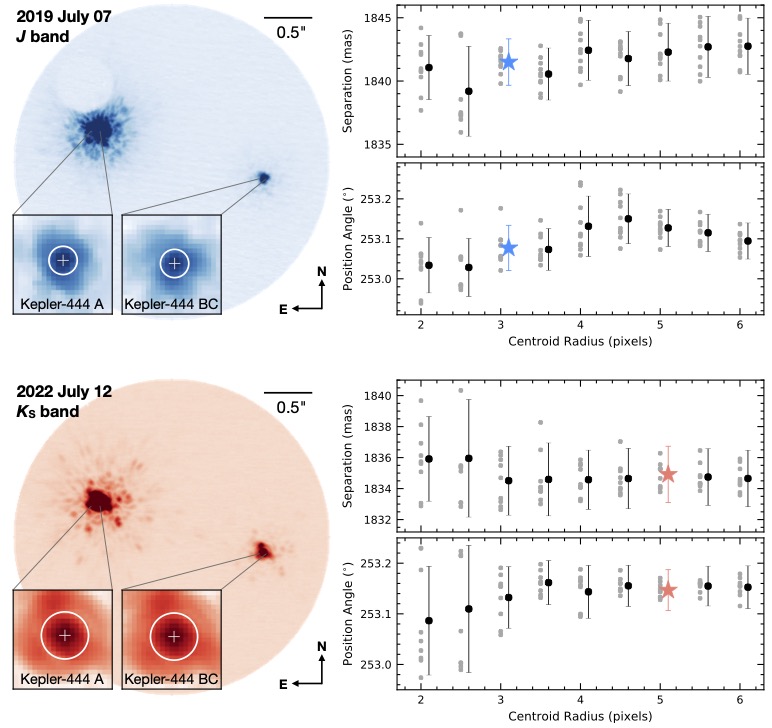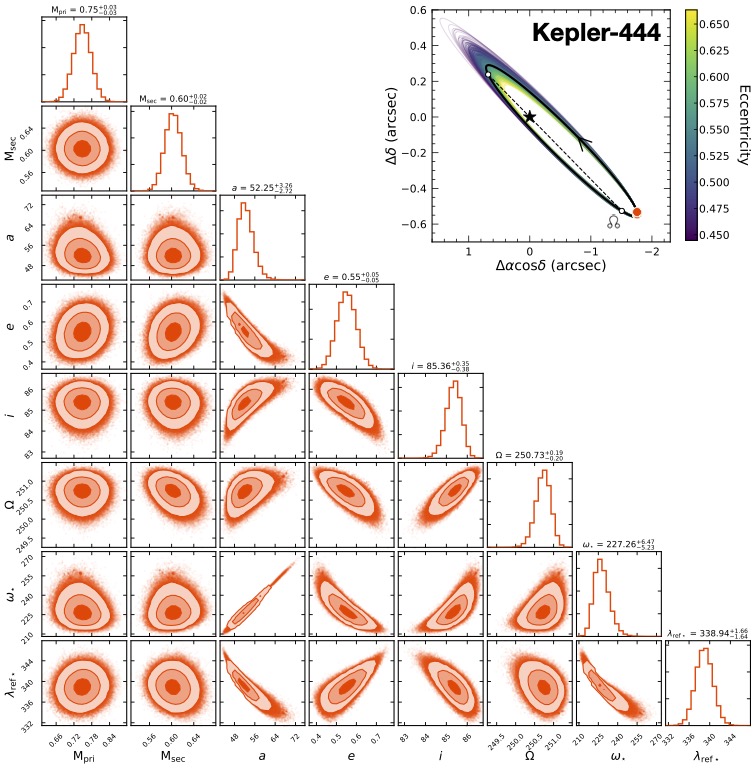Content
-
-
Uniform Forward-Modeling Analysis of Ultracool Dwarfs
- Paper I: Anchoring Sonora Bobcat Models --- Benchmark Late-T Dwarfs & Starfish Methodology
- Paper II: Anchoring Sonora Bobcat Models --- An Ensemble of 55 Late-T Dwarfs & Starfish
- Paper III: Testing BT-Settl Models --- An Ensemble of 90 Late-M and L Dwarfs
- Paper IV: Anchoring Sonora Diamondback and Saumon & Marley Models --- An Ensemble of 140 Benchmark late-M/L/T Dwarfs
-
Uniform Forward-Modeling Analysis of Ultracool Dwarfs
ELPIS (ELemental abundances of Planets and brown dwarfs Imaged around Stars)
ELPIS is a program focused on measuring atmospheric composition of directly imaged exoplanets, benchmark brown dwarfs, and their parent stars. By analyzing high-quality spectroscopic data for a broad ensemble of objects, we aim to constrain their atmospheric properties and assess how these properties reveal clues about their formation pathways and evolutionary processes on a population level.
- ELPIS Paper I: AF Lep A+b --- atmospheric metal enrichment and a new retrieval approach (Zhang et al. 2023c, AJ, 166, 198)
ELemental abundances of Planets and brown dwarfs Imaged around Stars (ELPIS). I. Potential Metal Enrichment of the Exoplanet AF Lep b and a Novel Retrieval Approach for Cloudy Self-luminous Atmospheres
Abstract
AF Lep A+b is a remarkable planetary system hosting a gas-giant planet that has the lowest dynamical mass among directly imaged exoplanets. We present an in-depth analysis of the atmospheric composition of the star and planet to probe the planet’s formation pathway. Based on new high-resolution spectroscopy of AF Lep A, we measure a uniform set of stellar parameters and elemental abundances (e.g., [Fe/H] = −0.27 ± 0.31 dex). The planet’s dynamical mass (2.8+0.6 MJup) and orbit are also refined using published radial velocities, relative astrometry, and absolute astrometry. We use petitRADTRANS to perform chemically consistent atmospheric retrievals for AF Lep b. The radiative–convective equilibrium temperature profiles are incorporated as parameterized priors on the planet’s thermal structure, leading to a robust characterization for cloudy self- luminous atmospheres. This novel approach is enabled by constraining the temperature–pressure profiles via the temperature gradient (dlnT/dlnP), a departure from previous studies that solely modeled the temperature. Through multiple retrievals performed on different portions of the 0.9–4.2 μm spectrophotometry, along with different priors on the planet’s mass and radius, we infer that AF Lep b likely possesses a metal-enriched atmosphere ([Fe/H] > 1.0 dex). AF Lep b’s potential metal enrichment may be due to planetesimal accretion, giant impacts, and/or core erosion. The first process coincides with the debris disk in the system, which could be dynamically excited by AF Lep b and lead to planetesimal bombardment. Our analysis also determines Teff ≈ 800 K, log(g) » 3.7 dex, and the presence of silicate clouds and disequilibrium chemistry in the atmosphere. Straddling the L/T transition, AF Lep b is thus far the coldest exoplanet with suggested evidence of silicate clouds.
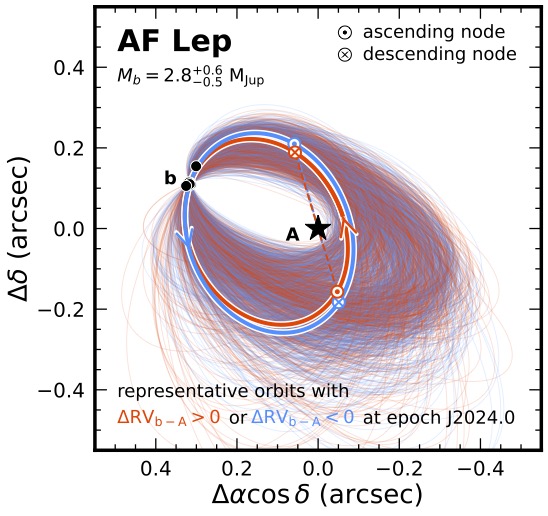
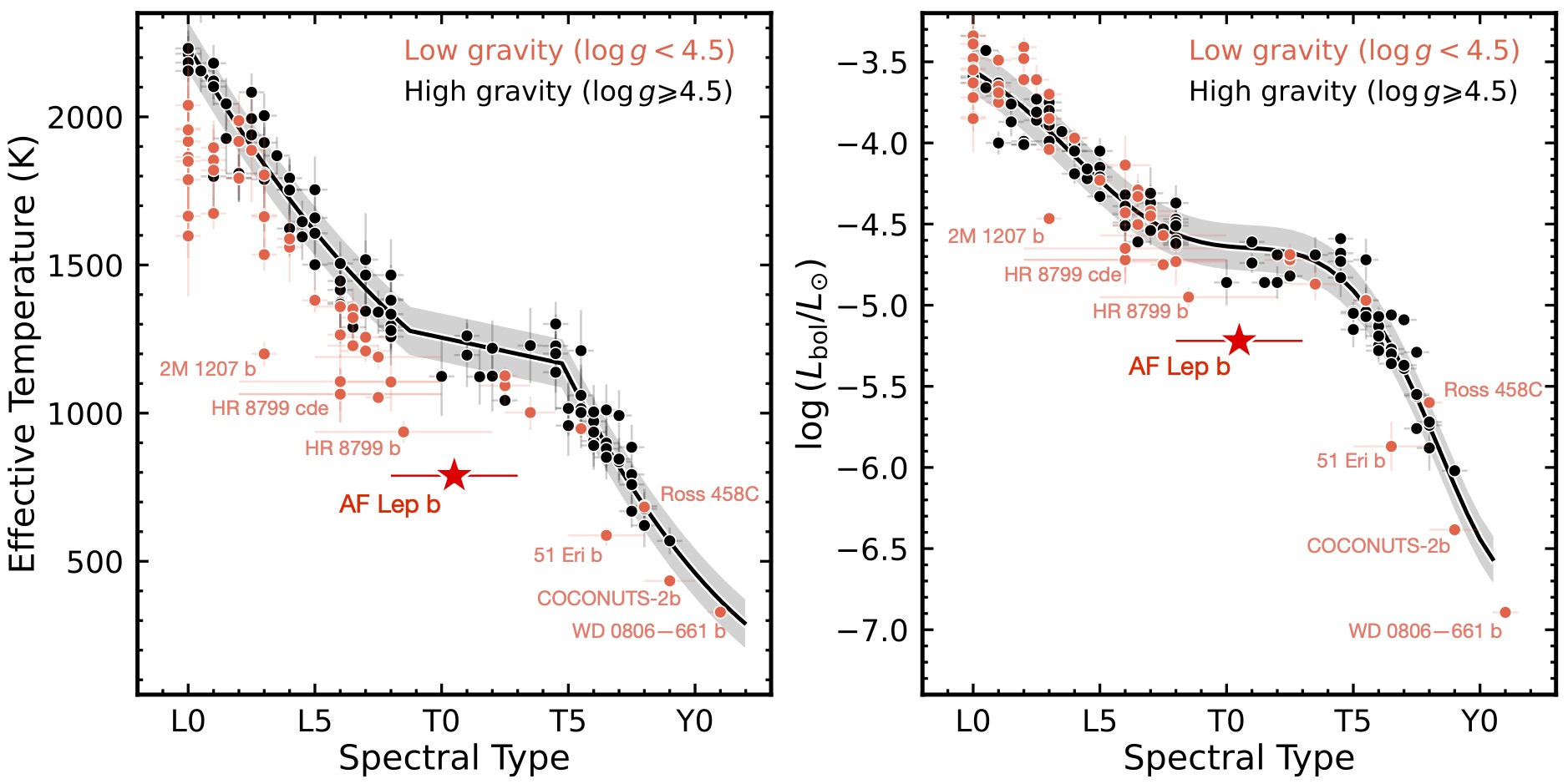
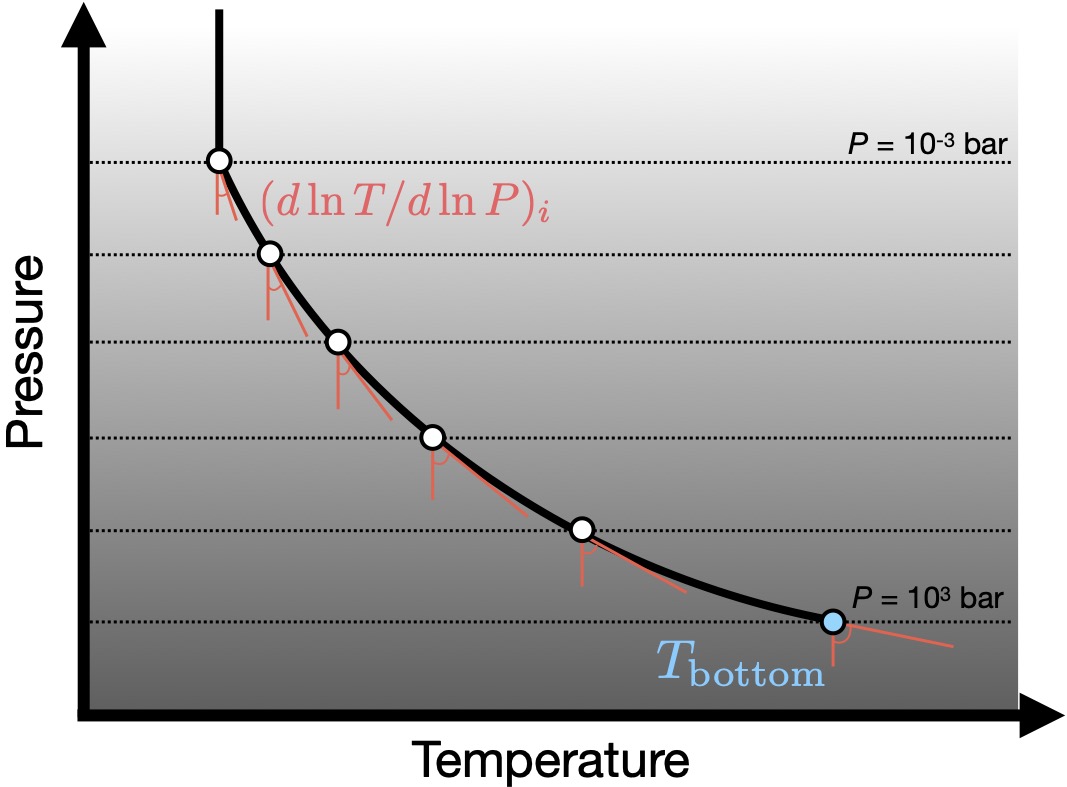
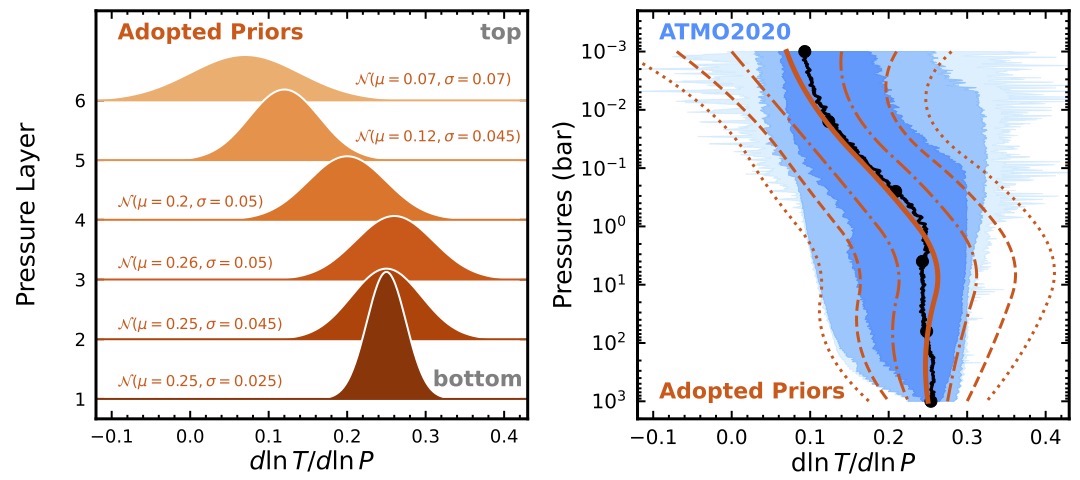
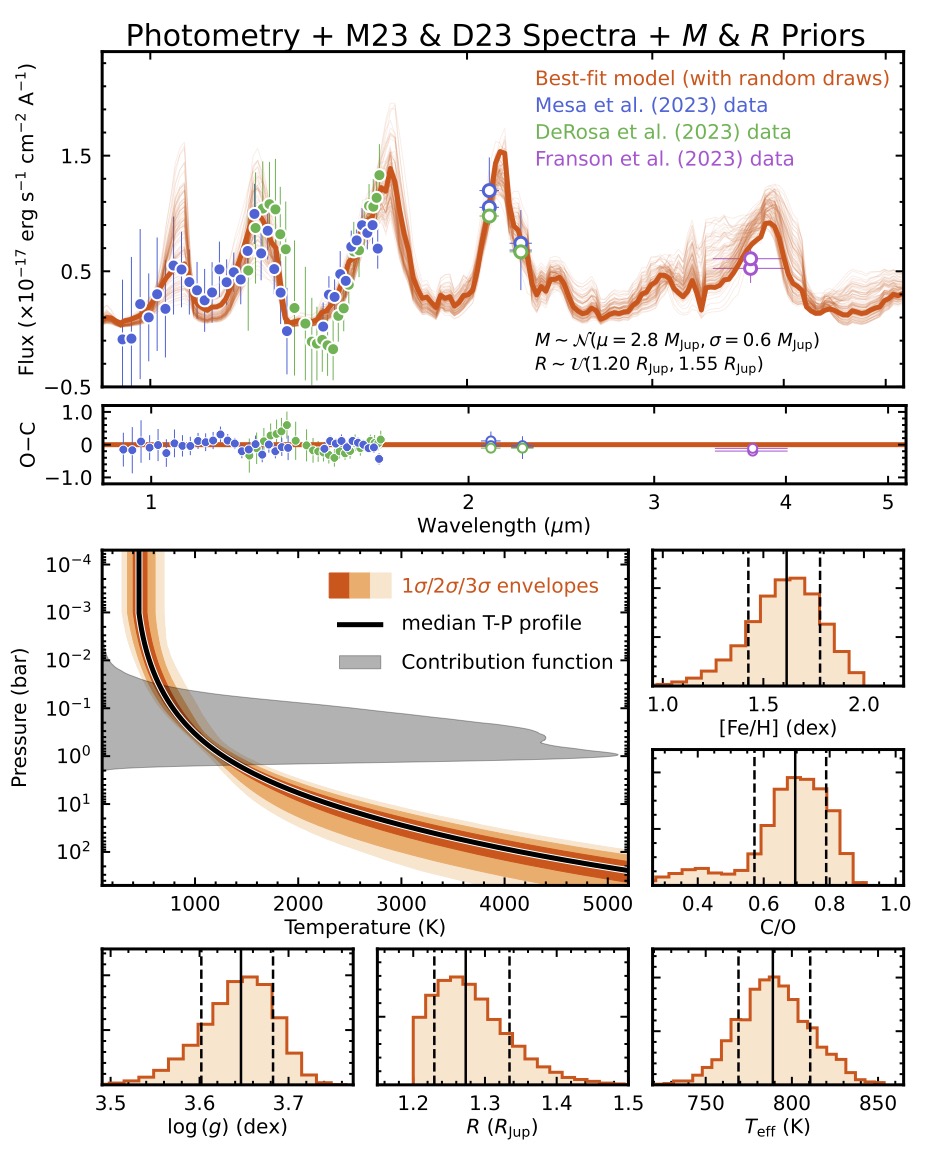
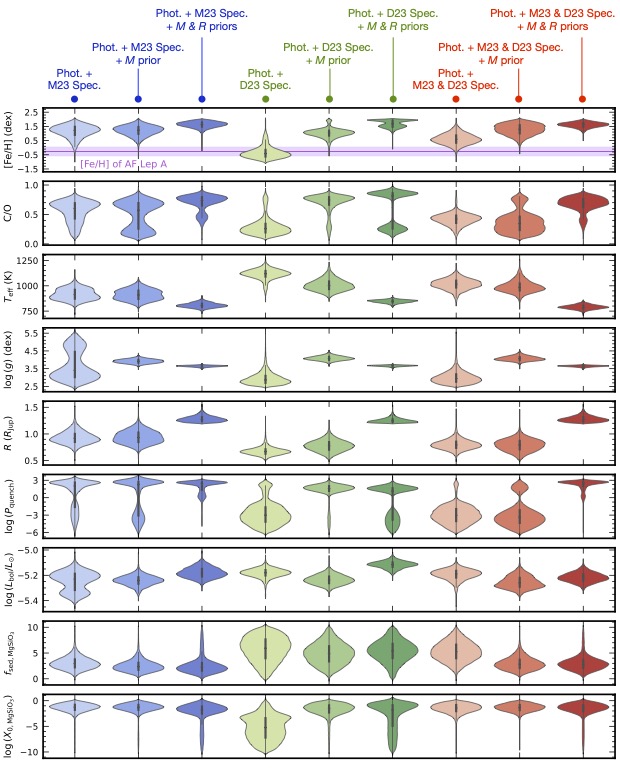
- ELPIS Paper II: 2MASS 1207 b --- retrievals of inhomogeneous atmospheres (Zhang et al. 2025b, AJ, in press)
ELemental abundances of Planets and brown dwarfs Imaged around Stars (ELPIS): II. The Jupiter-like Inhomogeneous Atmosphere of the First Directly Imaged Planetary-Mass Companion 2MASS 1207 b
Abstract
2MASS 1207 b, the first directly imaged planetary-mass companion, has been instrumental in advancing our understanding of exoplanets and brown dwarfs over the past 20 years. We have performed extensive atmospheric retrieval analyses of 2MASS 1207 b’s JWST/NIRSpec spectrum using petitRADTRANS and a new atmospheric inhomogeneity framework, which characterizes homogeneous atmospheres, patchy clouds, cloud-free hot spots, or the combination of patchy clouds and spots. Among 24 retrieval runs with various assumptions, the most statistically preferred model corresponds to the patchy cloud scheme, with Teff = 1174+4 K, log(g) = 3.62+0.03 dex, and R = 1.399+0.008 RJup, along with near-solar atmospheric compositions of [M/H]= −0.05 ± 0.03 dex and C/O= 0.440 ± 0.012. This model suggests ∼9% of 2MASS 1207 b’s atmosphere is covered by thin iron and silicate clouds, producing L-dwarf-like spectra, while the remaining 91% consists of thick iron and silicate clouds, emitting blackbody-like spectra. These thin-cloud patches and thick-cloud regions resemble Jupiter’s belts and zones, respectively, and this scenario is consistently supported by other retrieval runs incorporating inhomogeneous atmospheres. We demonstrate that the weak CO absorption of 2MASS 1207 b can be explained by the veiling effects of patchy thick clouds; the absence of 3.3 μm CH4 absorption is attributed to its hot thermal structure, which naturally leads to a CO-dominant, CH4-deficient atmosphere. The retrieved atmospheric models also match the observed variability amplitudes of 2MASS 1207 b. Our analysis reveals that the inferred atmospheric properties show significant scatter in less statistically pre- ferred retrieval runs but converge to consistent values among the preferred ones. This underscores the importance of exploring diverse assumptions in retrievals to avoid biased interpretations of atmospheric properties and formation pathways.
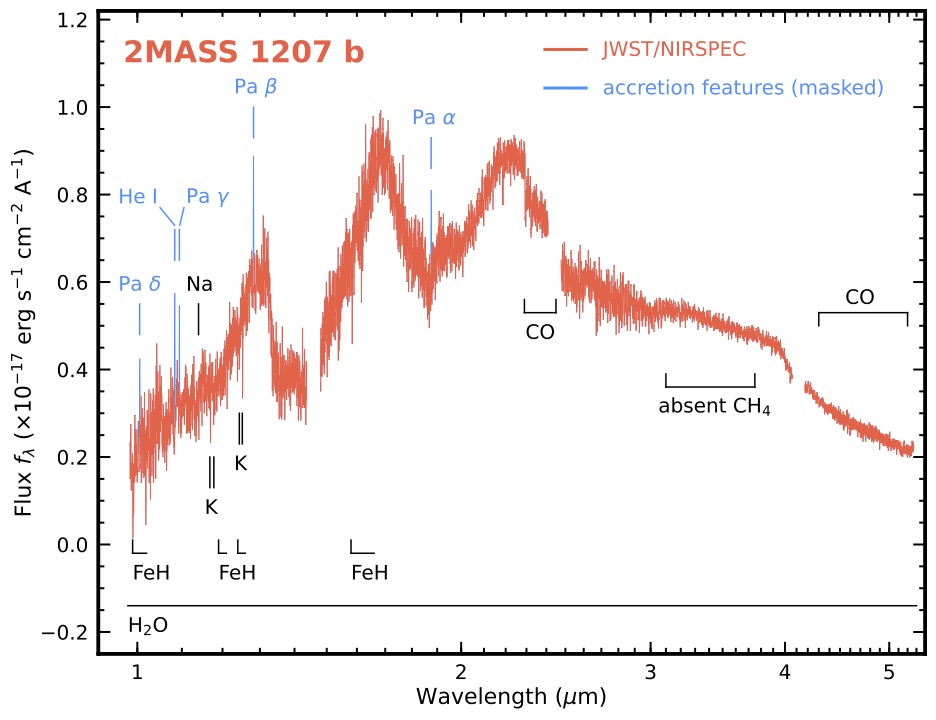

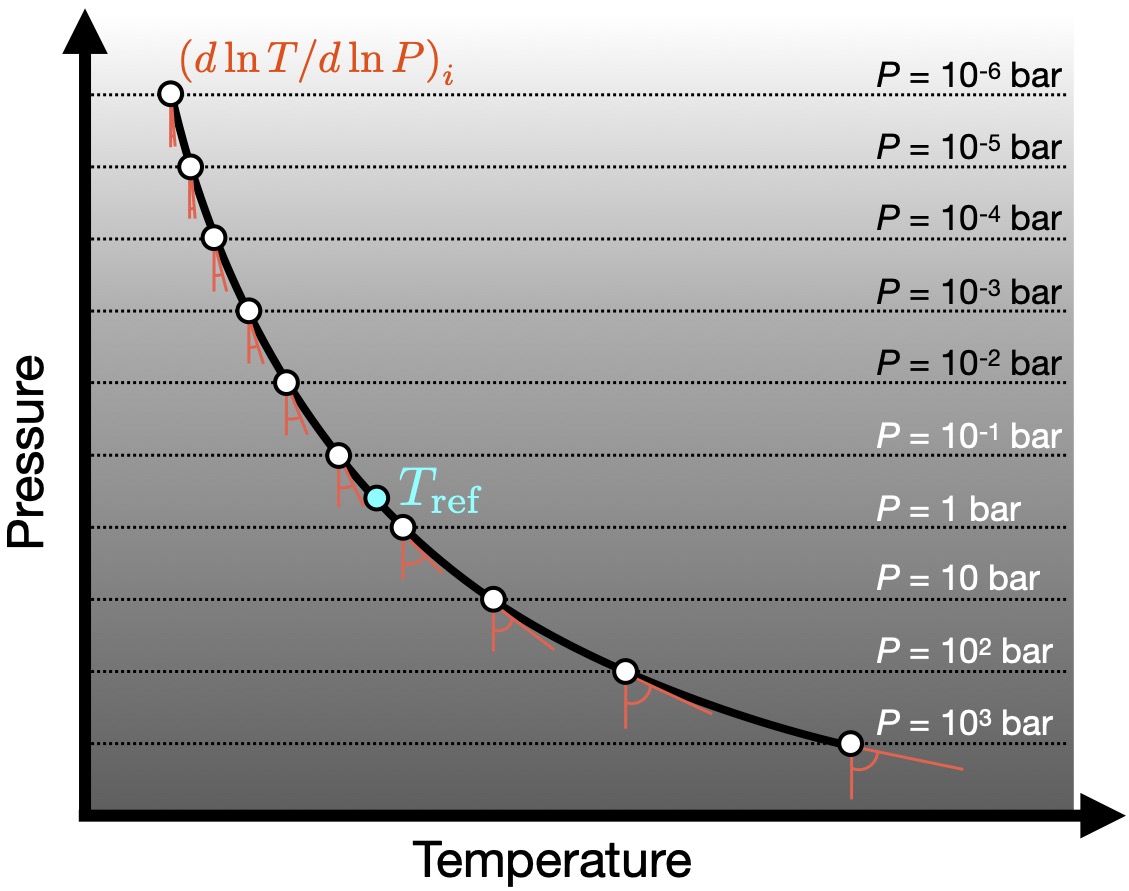
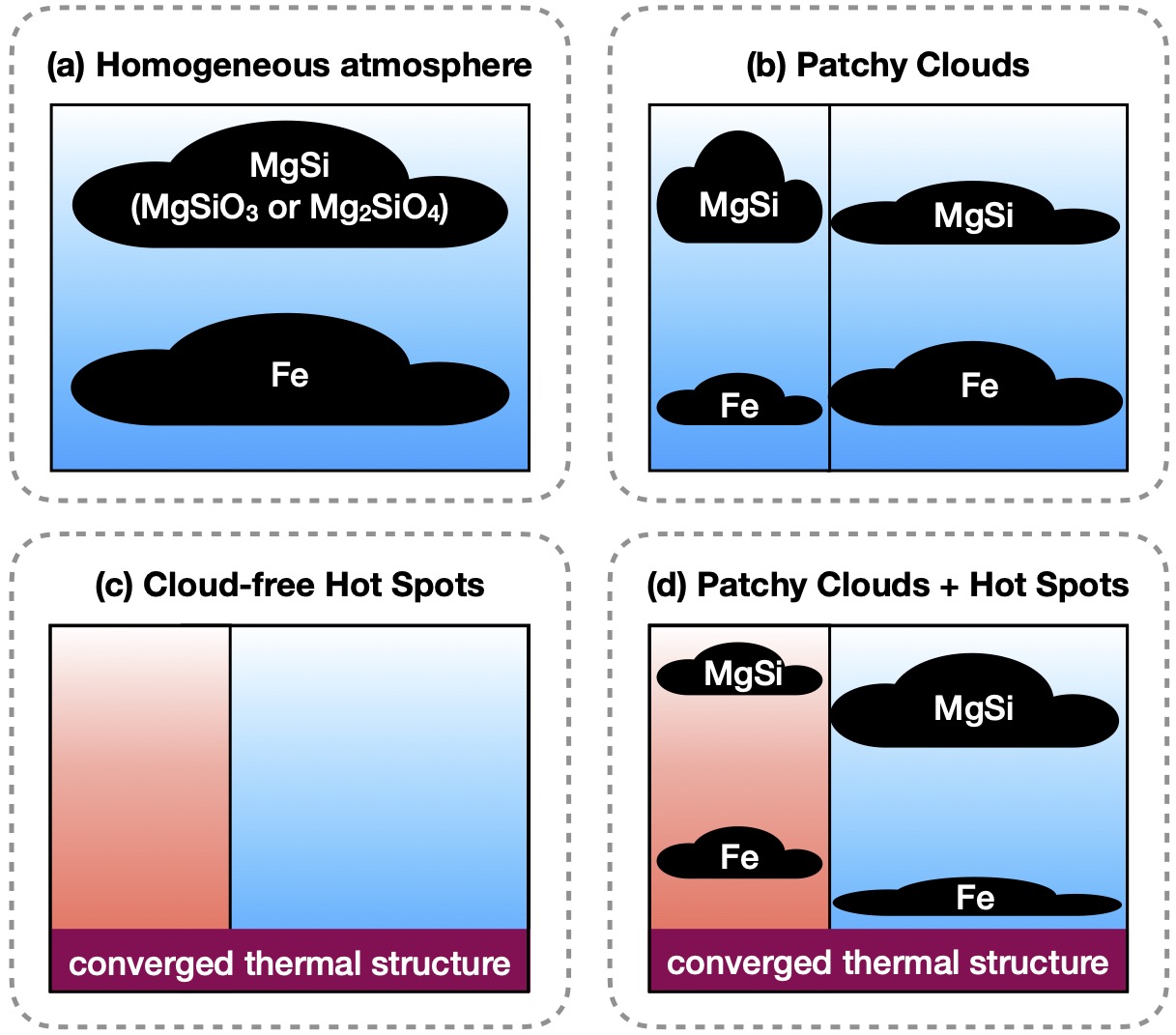
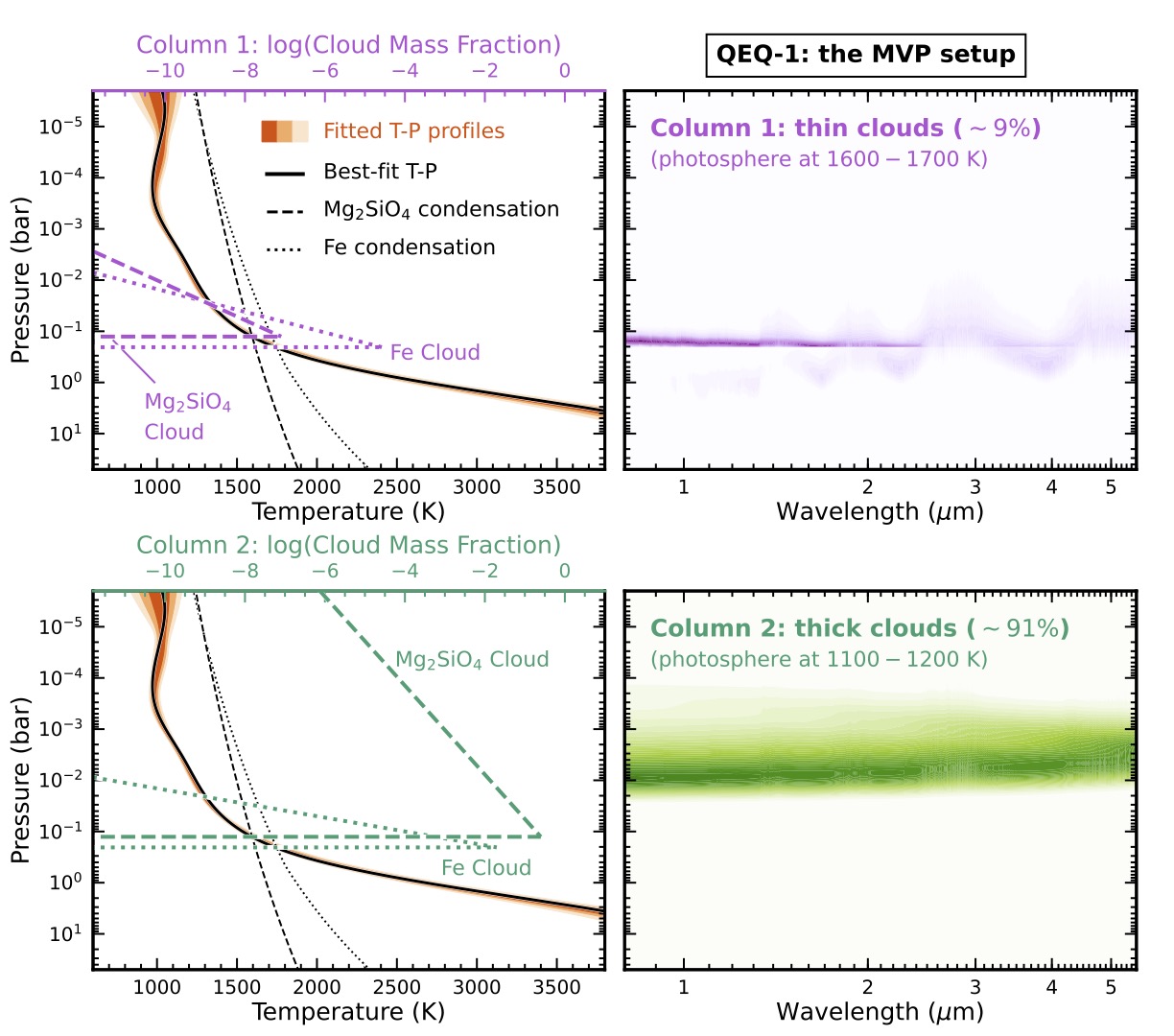
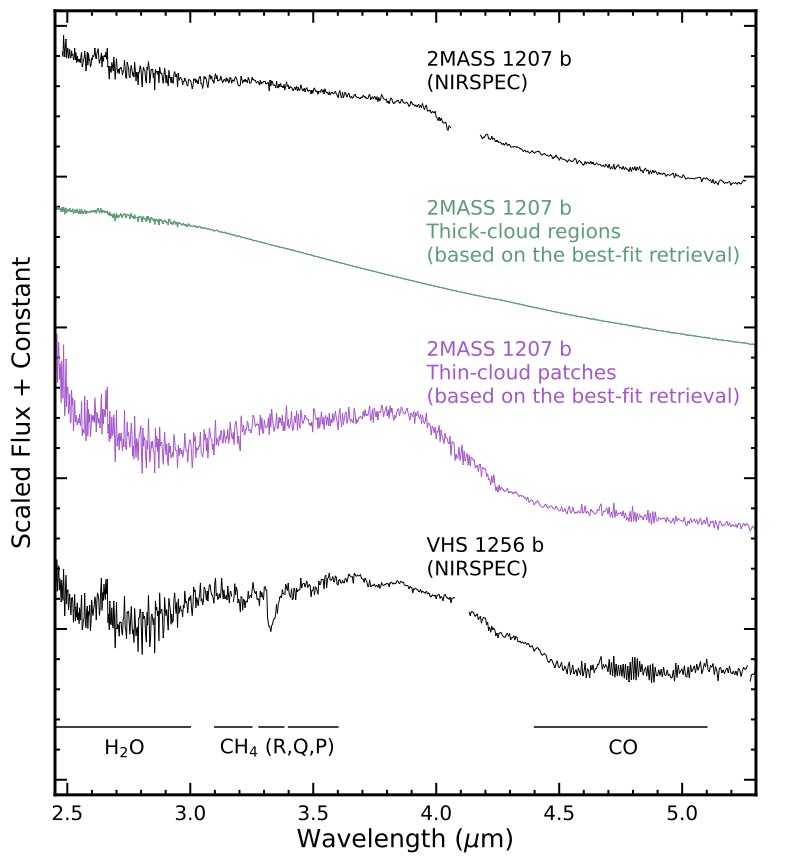
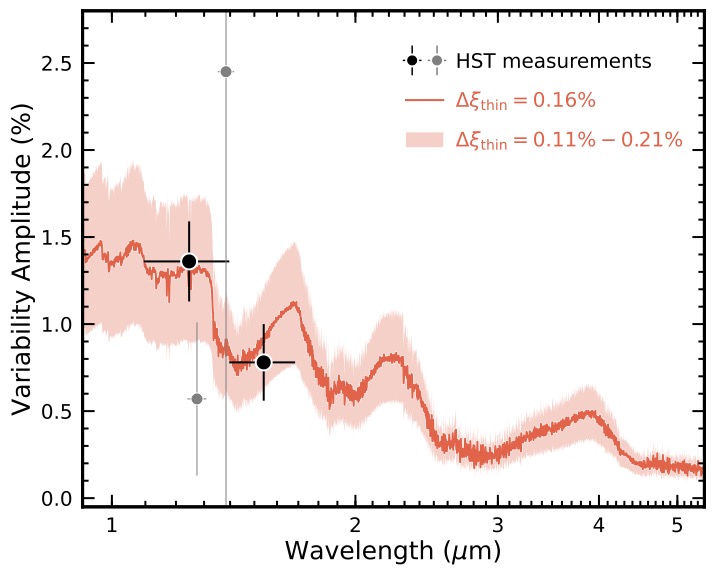
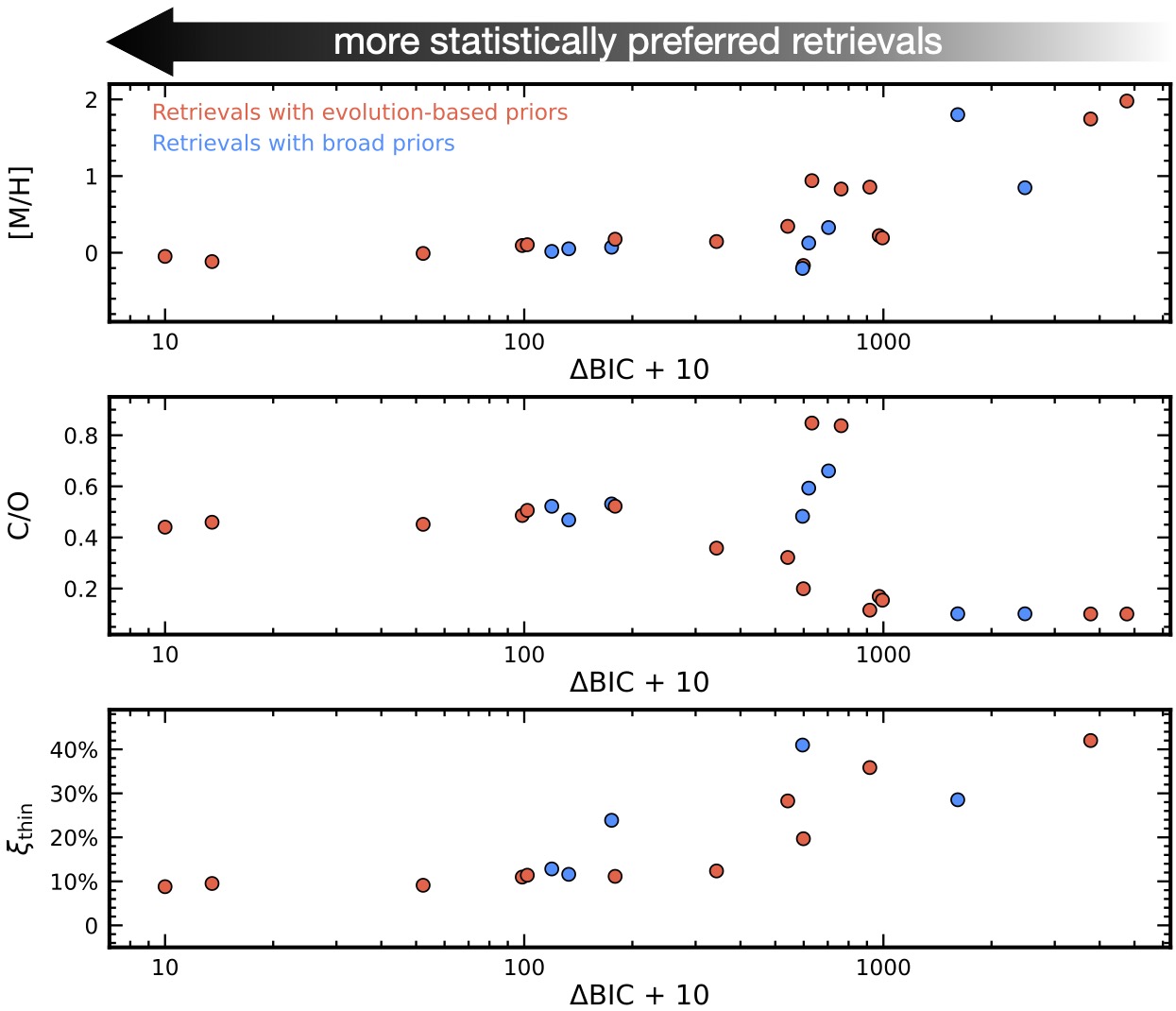
- Spectroscopic Characterization of COCONUTS-2b (Zhang et al. 2025a, AJ, 169, 9)
Disequilibrium Chemistry, Diabatic Thermal Structure, and Clouds in the Atmosphere of COCONUTS-2b
Abstract
Located 10.888 pc from Earth, COCONUTS-2b is a planetary-mass companion to a young (150–800 Myr) M3 star, with a wide orbital separation (6471 au) and a low companion-to-host mass ratio (0.021 ± 0.005). We have studied the atmospheric properties of COCONUTS-2b using newly acquired 1.0–2.5 μm spectroscopy from Gemini/Flamingos-2. The spectral type of COCONUTS-2b is refined to T9.5 ± 0.5 based on comparisons with T/Y dwarf spectral templates. We have conducted an extensive forward-modeling analysis, comparing the near-infrared spectrum and mid-infrared broadband photometry of COCONUTS-2b with 16 state-of-the-art atmospheric model grids developed for brown dwarfs and self-luminous exoplanets near the T/Y transition. The PH3-free ATMO2020++, ATMO2020++, and Exo-REM models best match the specific observations of COCONUTS-2b, regardless of variations in the input spectrophotometry. This analysis suggests the presence of disequilibrium chemistry, along with a diabatic thermal structure and/or clouds, in the atmosphere of COCONUTS-2b. All models predict fainter Y-band fluxes than observed, highlighting uncertainties in the alkali chemistry models and opacities. We determine a bolometric luminosity of log(Lbol/Lsun) = -6.18 dex, with a 0.5 dex wide range of [−6.43, −5.93] dex that accounts for various assumptions of atmospheric models. Using several thermal evolution models, we derive an effective temperature of Teff = 483 +44/-53 K, surface gravity of log(g) = 4.19 +0.18/-0.13 dex, a radius of R = 1.11 +0.03/-0.04 RJup, and a mass of M = 8 ± 2 MJup. Various atmospheric model grids consistently indicate that COCONUTS-2b’s atmosphere likely has subsolar or near-solar metallicity and C/O. These findings provide valuable insights into COCONUTS-2b’s formation history and the potential outward migration to its current wide orbit.
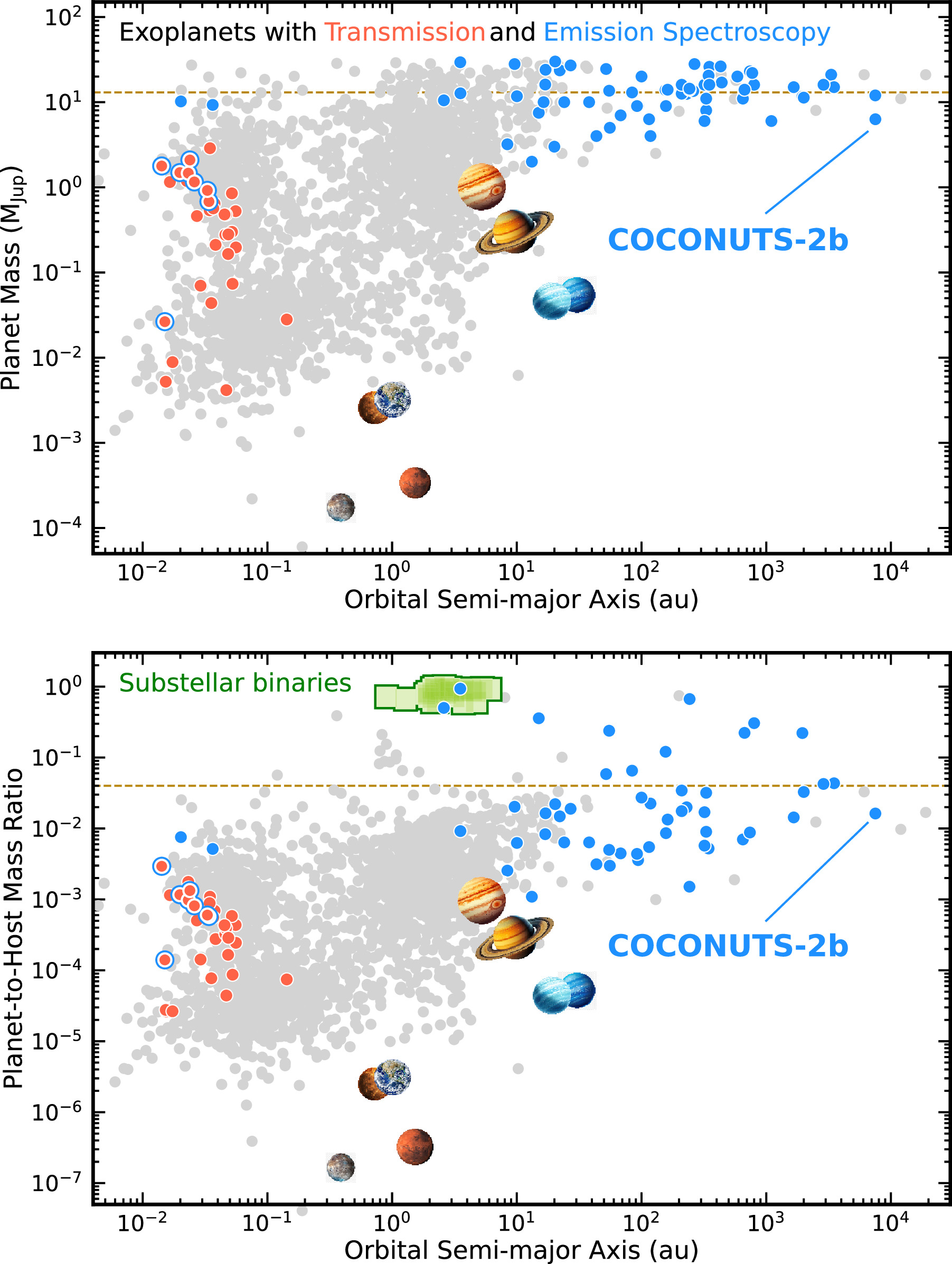
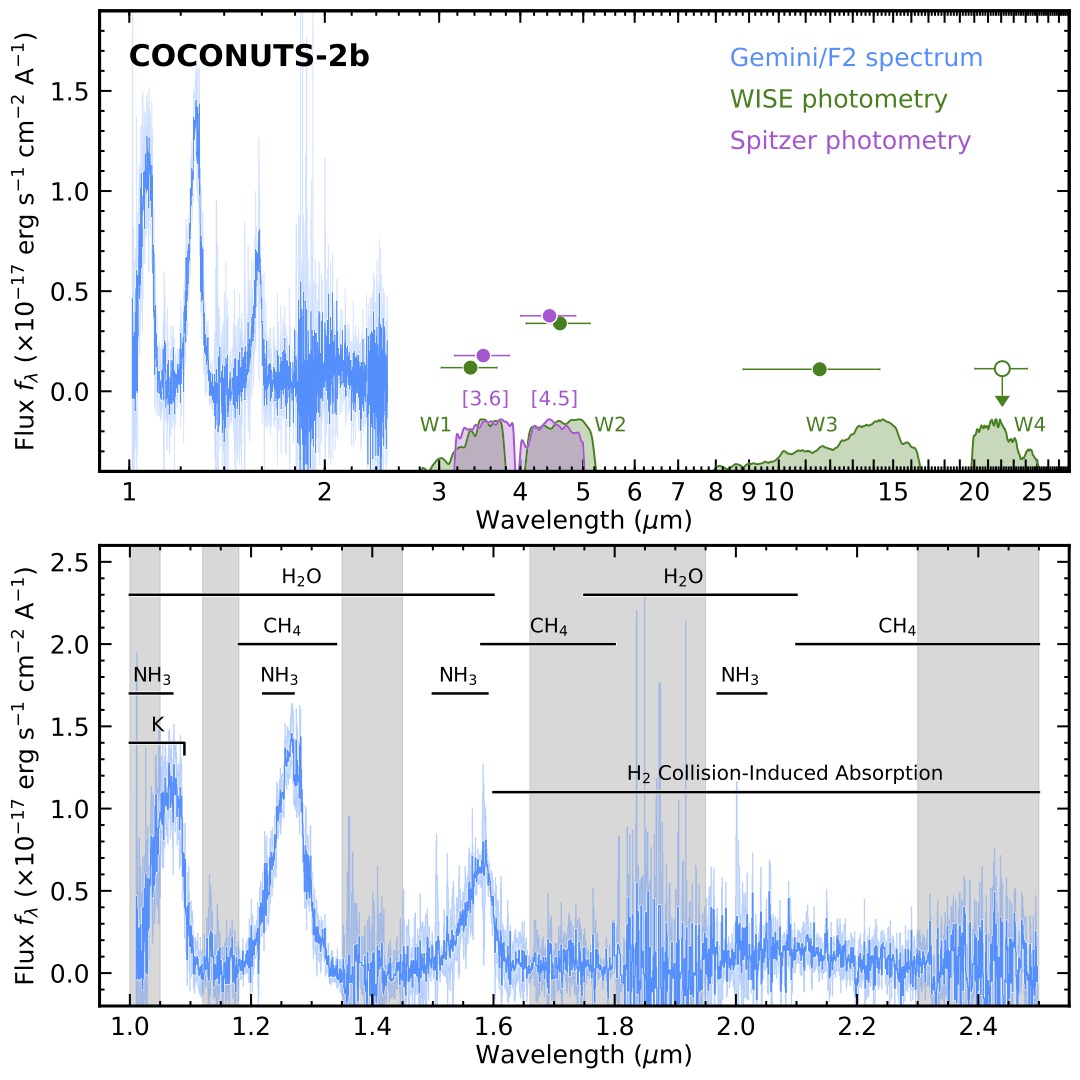

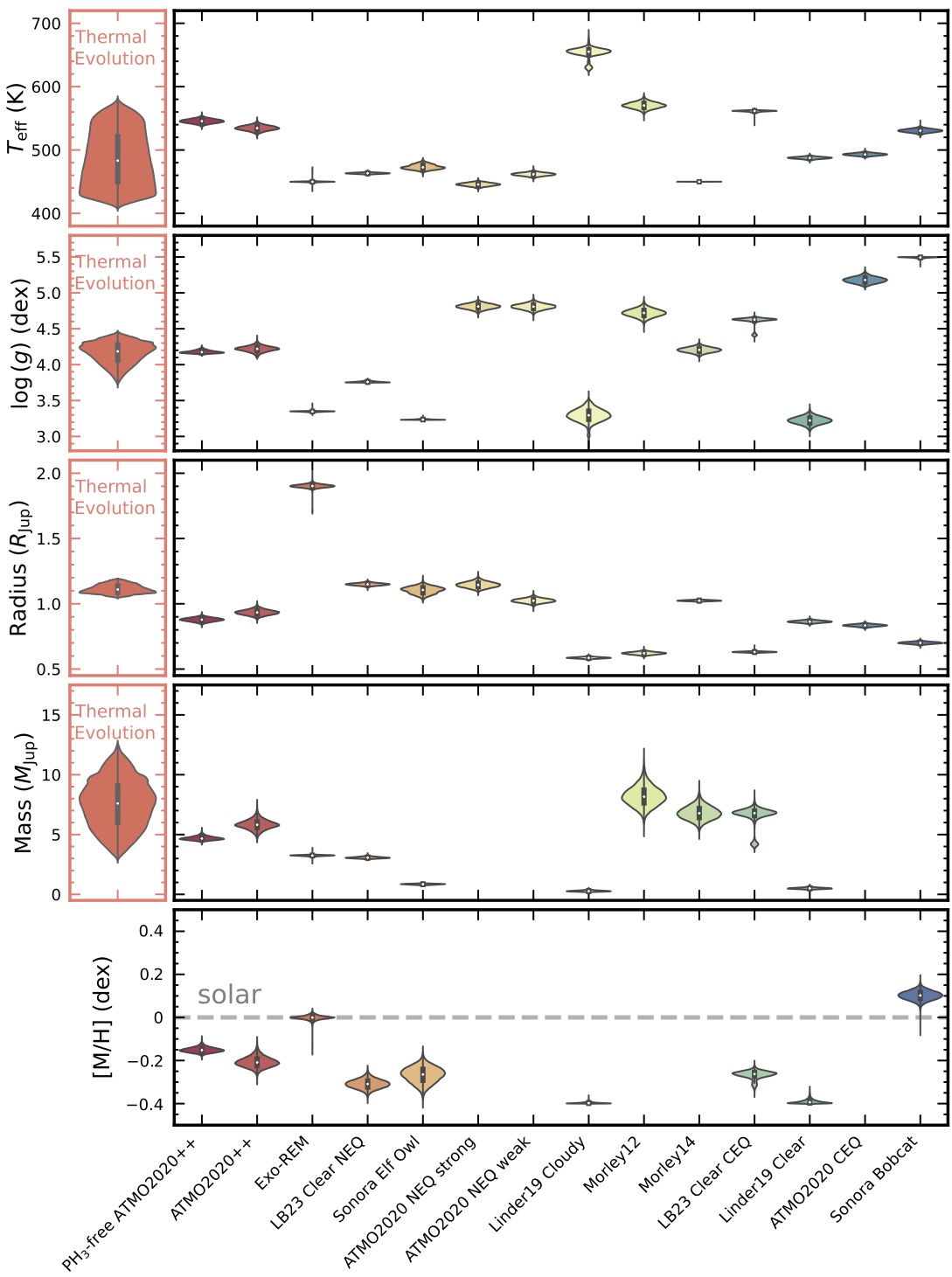
- Initial Entropy and Potential Delayed Formation of the Directly Imaged Exoplanet AF Lep b (Zhang 2024, RNAAS, 8, 114)
Initial Entropy and Potential Delayed Formation of the Directly Imaged Exoplanet AF Lep b
Abstract
AF Lep b is a rare directly imaged exoplanet with properties consistent with core-accretion evolution models. Using this planet’s precise dynamical mass and spectroscopically inferred bolometric luminosity alongside the Spiegel & Burrows (2012) evolution models, I derived an initial entropy >8.7 kB/baryon at 3σ and an age of 12±4 Myr. Comparing this planet’s age to the isochrone age (24±3 Myr) of its host association, the β Pictoris moving group (BPMG), suggests that AF Lep b formed 12±5 Myr later than its host star. Alternatively, considering BPMG’s updated kinematic age (16.3 +3.4/−2.1 Myr) suggests that AF Lep b formed 5±5 Myr after its host star’s formation, aligning more closely with protoplanetary disk dispersal timescales. The sensitivities of our findings to the planet’s mass and luminosity are also discussed. AF Lep b uniquely facilitates the constraints of its initial entropy and formation epoch, paving the way for similar insights into forthcoming exoplanet discoveries in the future.
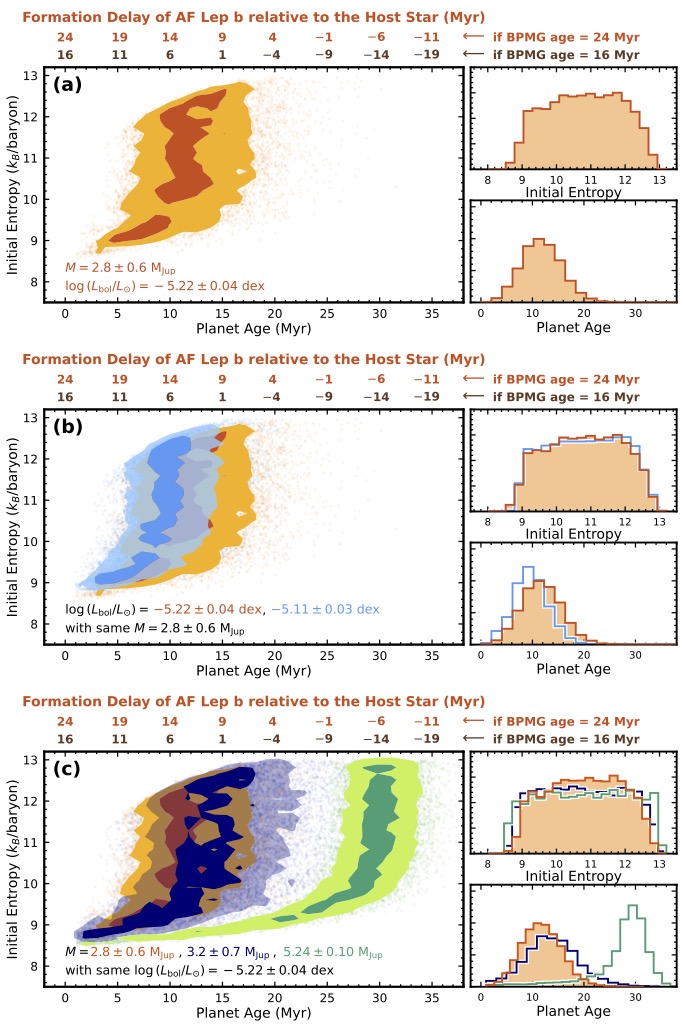
- Atmospheric Escape of the Hot Jupiter HAT-P-32b (Zhang et al. 2023b, Science Advances, 9, 23)
Giant tidal tails of helium escaping the hot Jupiter HAT-P-32 b
Abstract
Capturing planets in the act of losing their atmospheres provides rare opportunities to probe their evolution history. This analysis has been enabled by observations of the helium triplet at 10,833 angstrom, but past studies have focused on the narrow time window right around the planet's optical transit. We monitored the hot Jupiter HAT-P-32 b using high-resolution spectroscopy from the Hobby-Eberly Telescope covering the planet's full orbit. We detected helium escaping HAT-P-32 b at a 14σ significance,with extended leading and trailing tails spanning a projected length over 53 times the planet's radius. These tails are among the largest known structures associated with an exoplanet. We interpret our observations using three-dimensional hydrodynamic simulations, which predict Roche Lobe overflow with extended tails along the planet's orbital path. Long-baseline monitoring of the HAT-P-32Ab system reveals helium escaping through tidal tails 50 times the size of the planet.
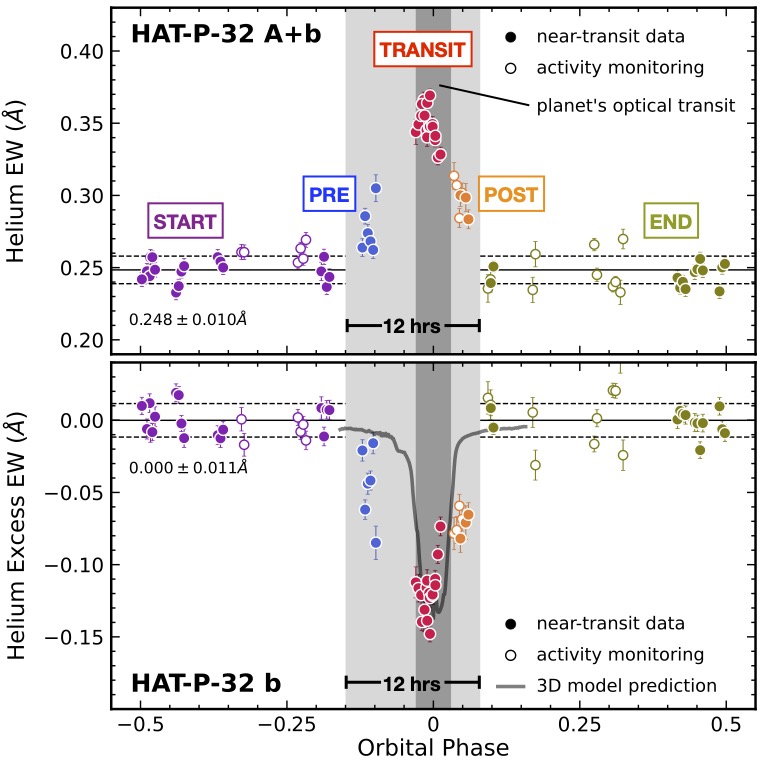
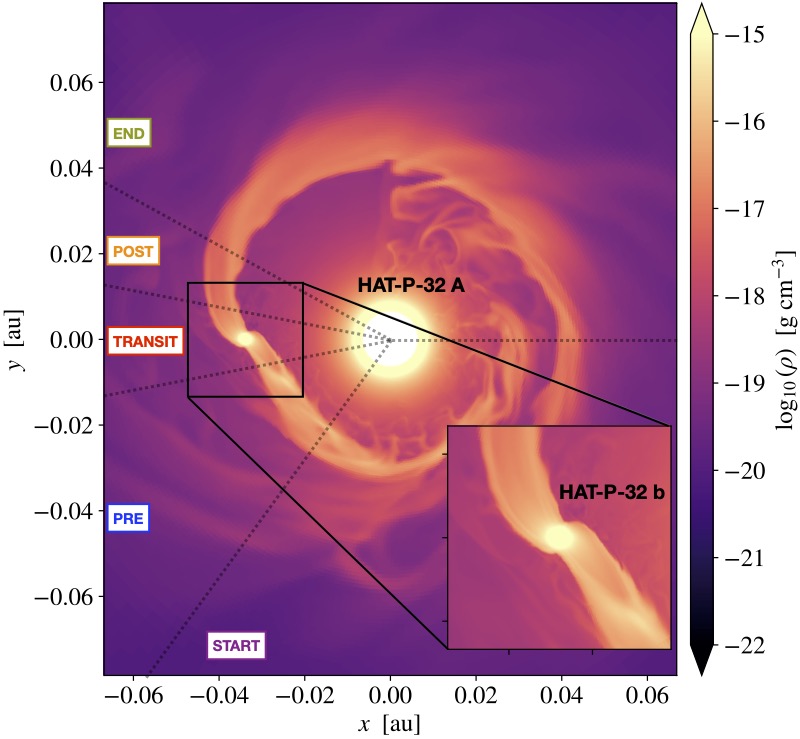
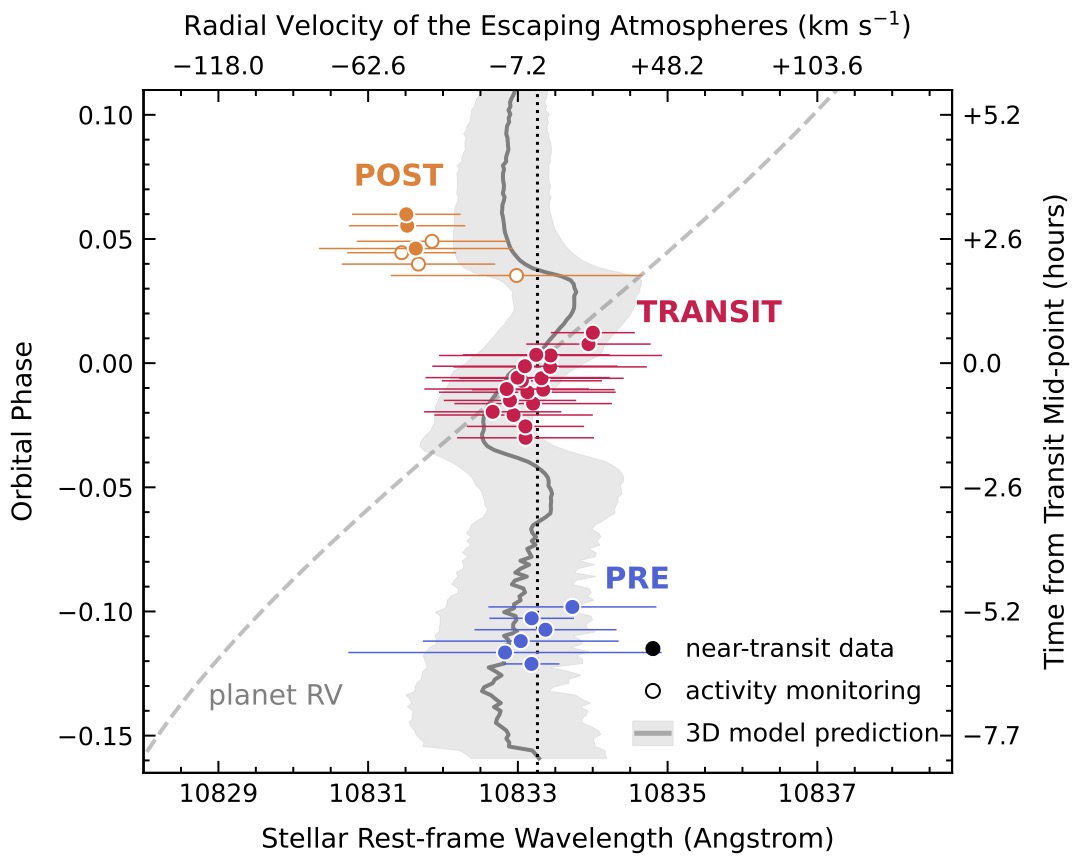
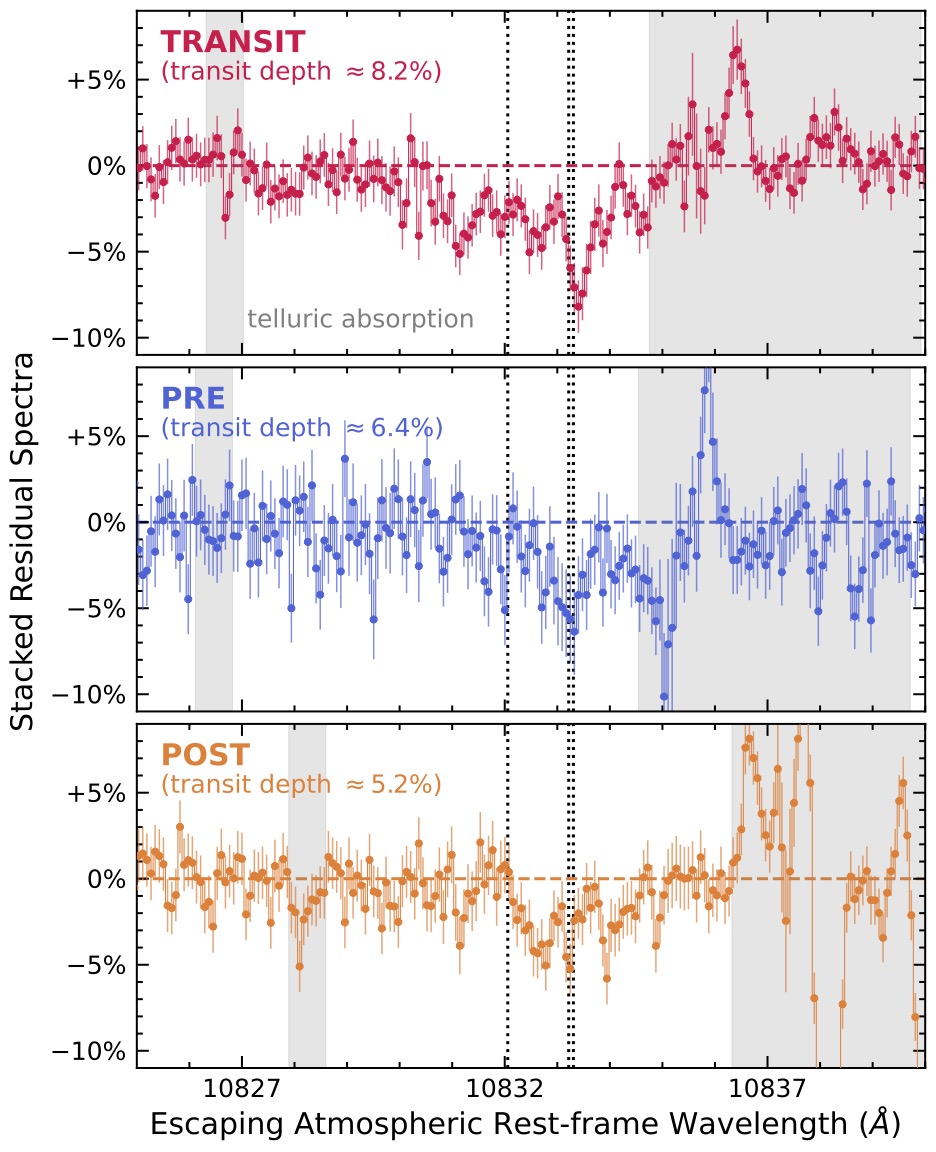
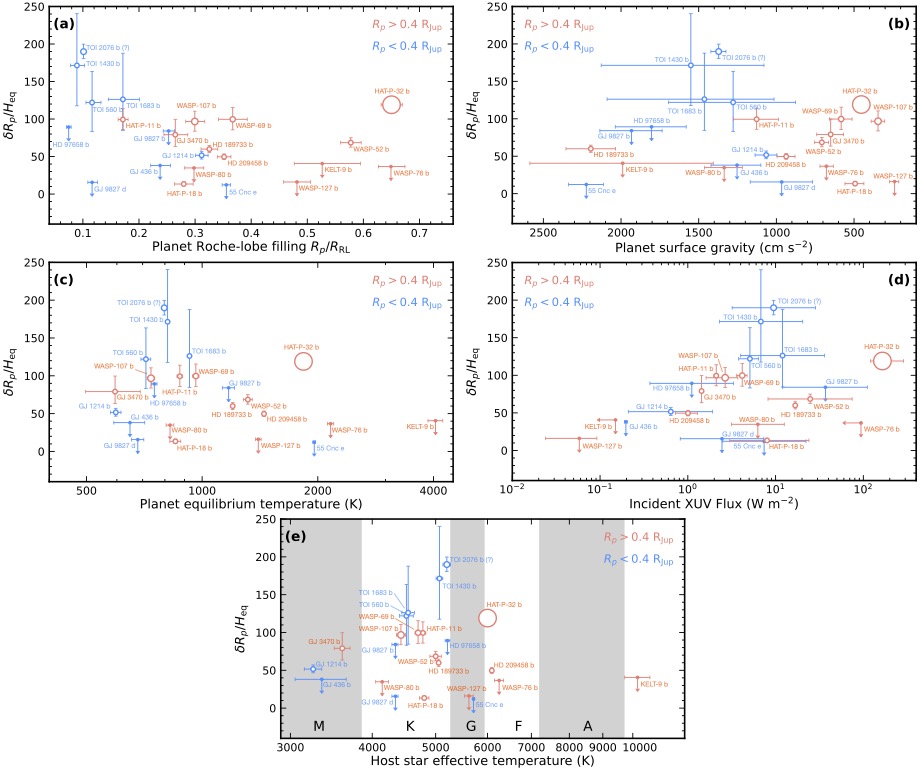
Uniform Forward-Modeling Analysis of Ultracool Dwarfs
Uniform Forward-Modeling Analysis of Ultracool Dwarfs is a program that systematically compares observed spectra of brown dwarfs --- whether for a large ensemble or individual benchmarks --- with state-of-the-art forward models of exoplanet and brown dwarf atmospheres. The program aims to evaluate model performance, identify data-model discrepancies, and quantify systematic uncertainties in derived atmospheric properties. These results provide essential context for accurately interpreting ultracool dwarf atmospheres and for avoiding biased conclusions about their physical properties and formation pathways.
- Paper I: Anchoring Sonora Bobcat Models --- Benchmark Late-T Dwarfs & Starfish Methodology (Zhang et al. 2021b, ApJ, 916, 53)
Uniform Forward-modeling Analysis of Ultracool Dwarfs. I. Methodology and Benchmarking
Abstract
We present a forward-modeling framework using the Bayesian inference tool Starfish and cloudless Sonora-Bobcat model atmospheres to analyze low-resolution (R ≈ 80–250) near-infrared (1.0–2.5 μm) spectra of T dwarfs. Our approach infers effective temperatures, surface gravities, metallicities, radii, and masses, and by accounting for uncertainties from model interpolation and correlated residuals due to instrumental effects and modeling systematics, produces more realistic parameter posteriors than traditional (χ2-based) spectral-fitting analyses. We validate our framework by fitting the model atmospheres themselves and finding negligible offsets between derived and input parameters. We apply our methodology to three well-known benchmark late-T dwarfs, HD 3651B, GJ 570D, and Ross 458C, using both solar and nonsolar metallicity atmospheric models. We also derive these benchmarks’ physical properties using their bolometric luminosities, their primary stars’ ages and metallicities, and Sonora-Bobcat evolutionary models. Assuming the evolutionary-based parameters are more robust, we find our atmospheric-based, forward-modeling analysis produces two outcomes. For HD 3615B and GJ 570D, spectral fits provide accurate Teff and R but underestimated logg (by ≈1.2dex) and Z (by ≈0.35dex), likely due to the systematics from modeling the potassium line profiles. For Ross 458C, spectral fits provide accurate log g and Z but overestimated Teff (by ≈120 K) and underestimated R (by ≈1.6×), likely because our model atmospheres lack clouds, reduced vertical temperature gradients, or disequilibrium processes. Finally, the spectroscopically inferred masses of these benchmarks are all considerably underestimated.


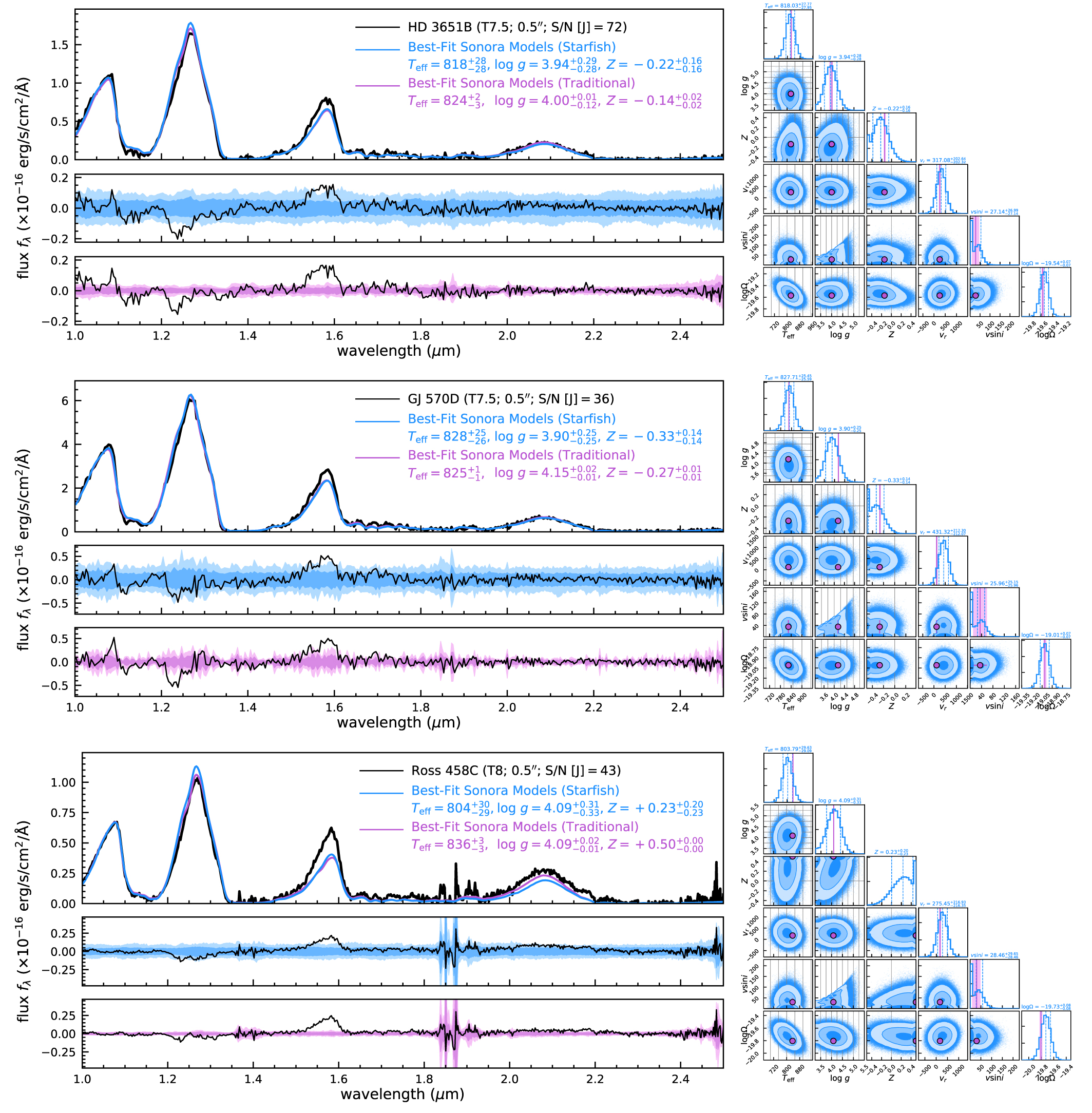
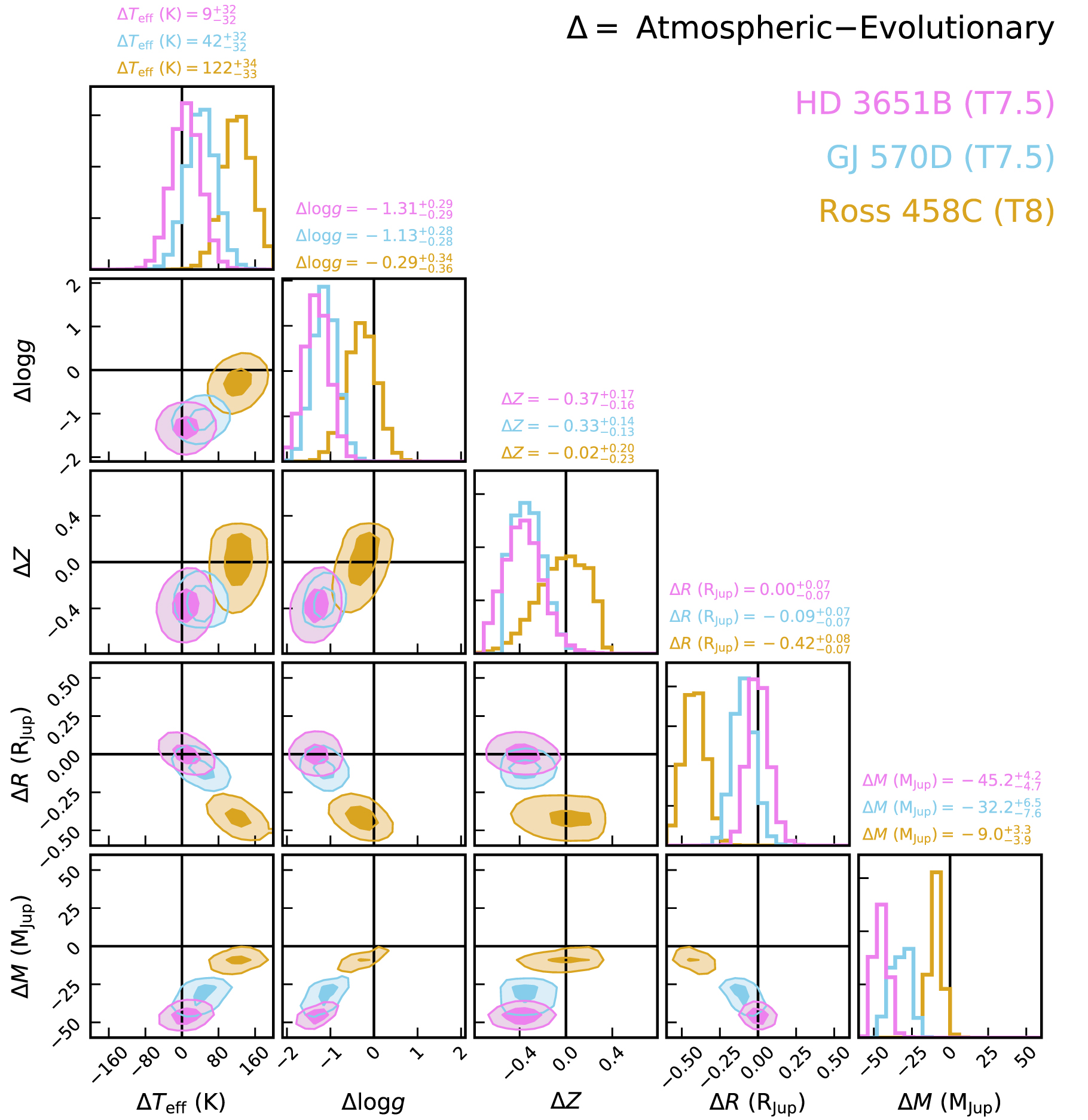
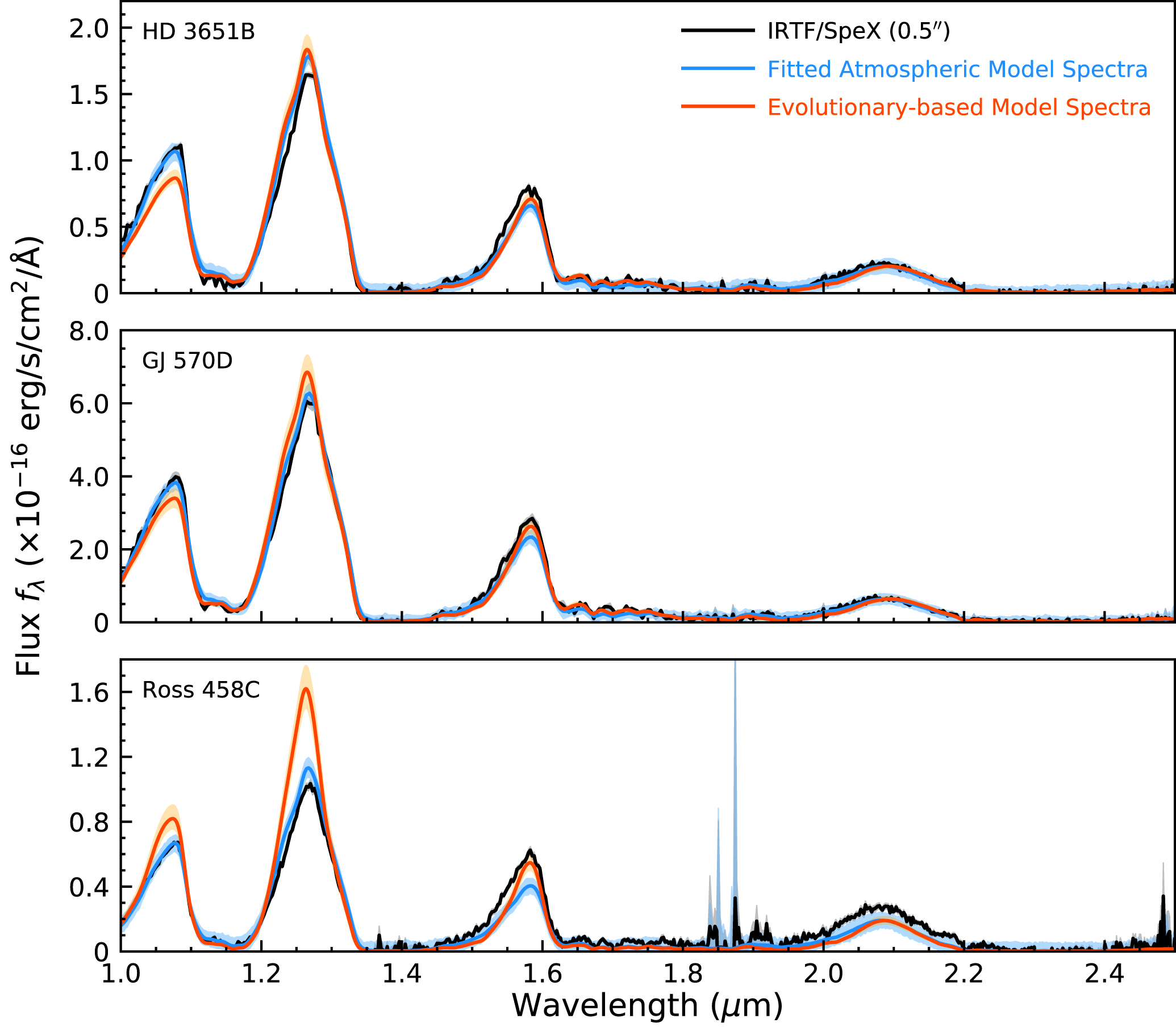
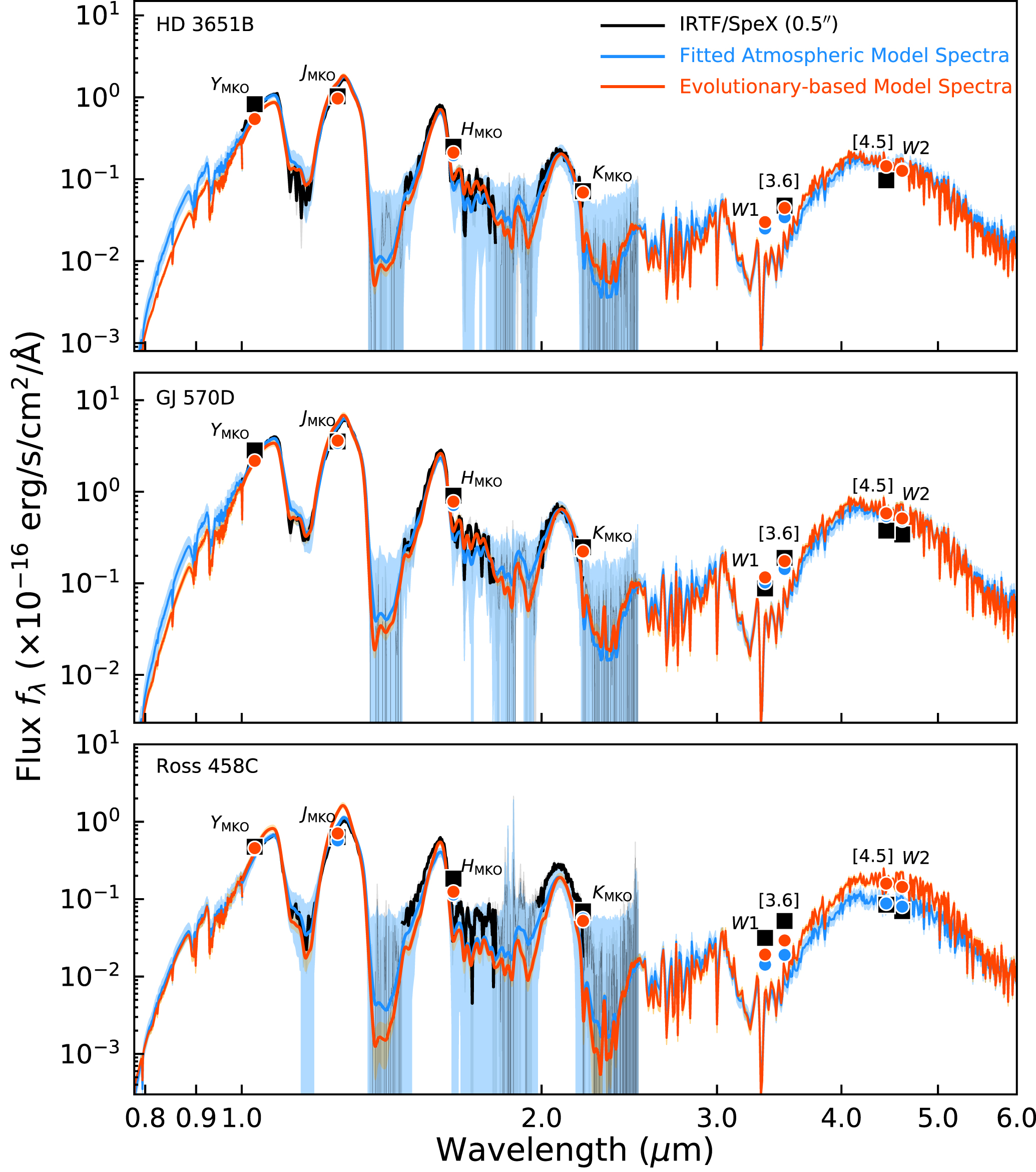
- Paper II: Anchoring Sonora Bobcat Models --- An Ensemble of 55 Late-T Dwarfs & Starfish (Zhang et al. 2021c, ApJ, 921, 95)
Uniform Forward-modeling Analysis of Ultracool Dwarfs. II. Atmospheric Properties of 55 Late-T Dwarfs
Abstract
We present a large uniform forward-modeling analysis for 55 late-T (T7–T9) dwarfs, using low-resolution (R ≈ 50–250) near-infrared (1.0–2.5 μm) spectra and cloudless Sonora–Bobcat model atmospheres. We derive the objects’ effective temperatures, surface gravities, metallicities, radii, masses, and bolometric luminosities using our newly developed Bayesian framework, and use the resulting population properties to test the model atmospheres. We find (1) our objects’ fitted metallicities are 0.3–0.4 dex lower than those of nearby stars; (2) their ages derived from spectroscopic parameters are implausibly young (10 Myr–0.4 Gyr); (3) their fitted effective temperatures show a similar spread to empirical temperature scales at a given spectral type but are ∼50–200 K hotter for T8 dwarfs; and (4) their spectroscopically inferred masses are unphysically small (mostly 1–8 MJup). These suggest the Sonora–Bobcat assumptions of cloudless and chemical-equilibrium atmospheres do not adequately reproduce late- T dwarf spectra. We also find a gravity and metallicity dependence of effective temperature as a function of spectral type. Combining the resulting parameter posteriors of our sample, we quantify the degeneracy between the fitted surface gravity and metallicity such that an increase in Z combined with a 3.4× increase in logg results in a spectrum that has similar fitted parameters. We note the systematic difference between the late-T dwarf spectra and Sonora–Bobcat models is on average ≈2%–4% of the objects’ peak J-band fluxes over the 1.0–2.5 μm range, implying modeling systematics will exceed measurement uncertainties when analyzing data with J-band S/N >~ 50. Using our large, high-quality sample, we examine the spectral-fitting residuals as a function of wavelength and atmospheric properties to discern how to improve the model assumptions. Our work constitutes the largest analysis of brown dwarf spectra using multimetallicity models and the most systematic examination of ultracool model atmospheres to date.
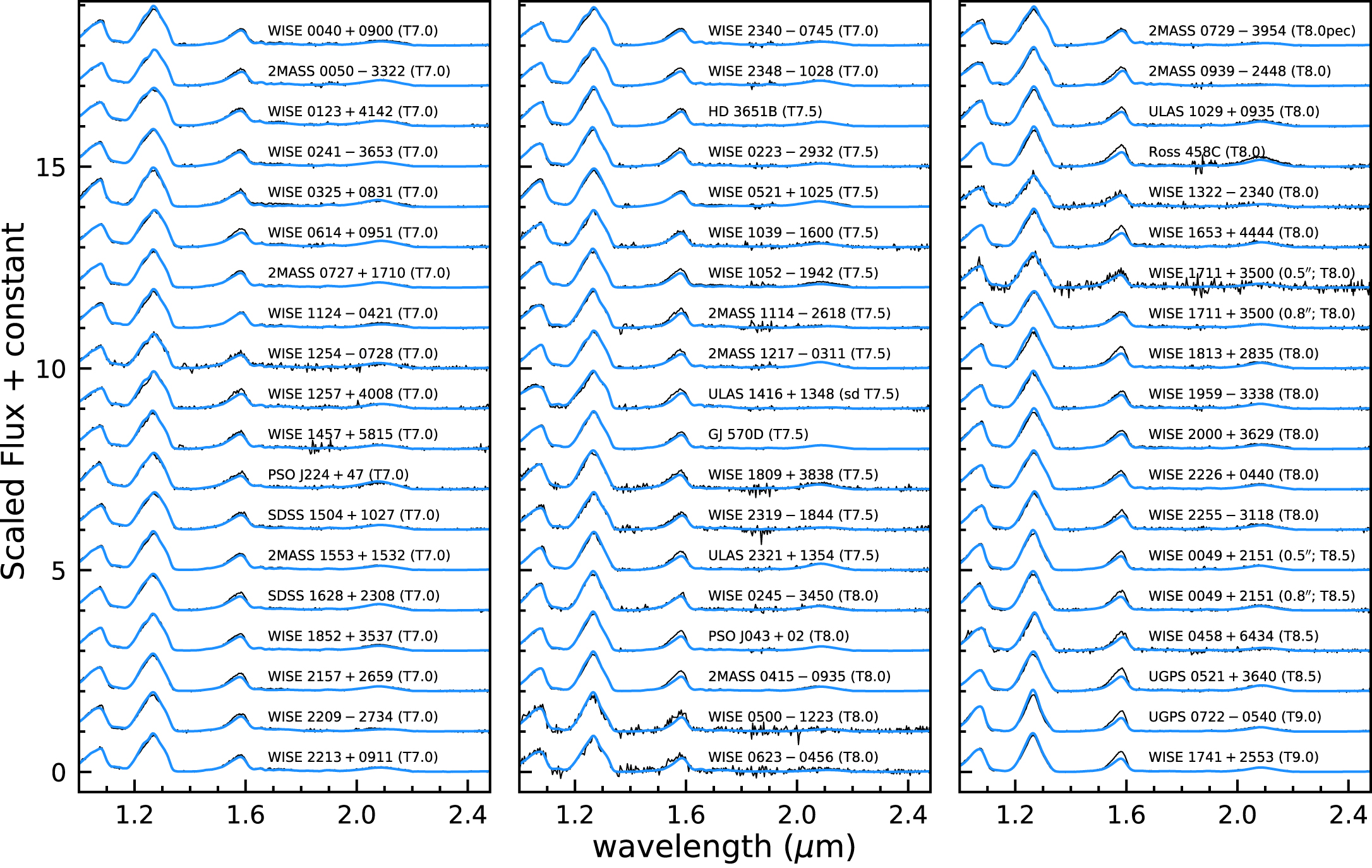

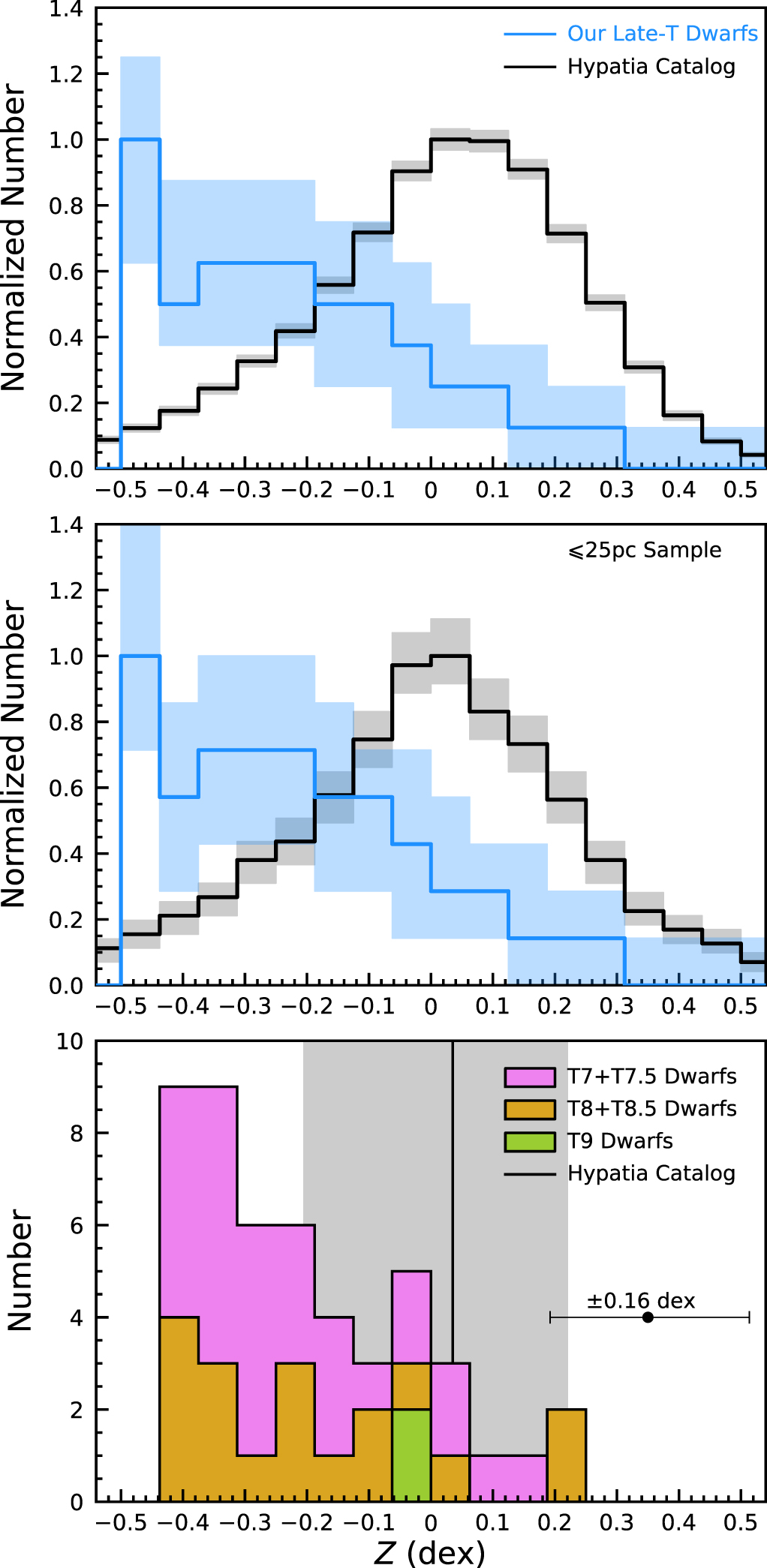



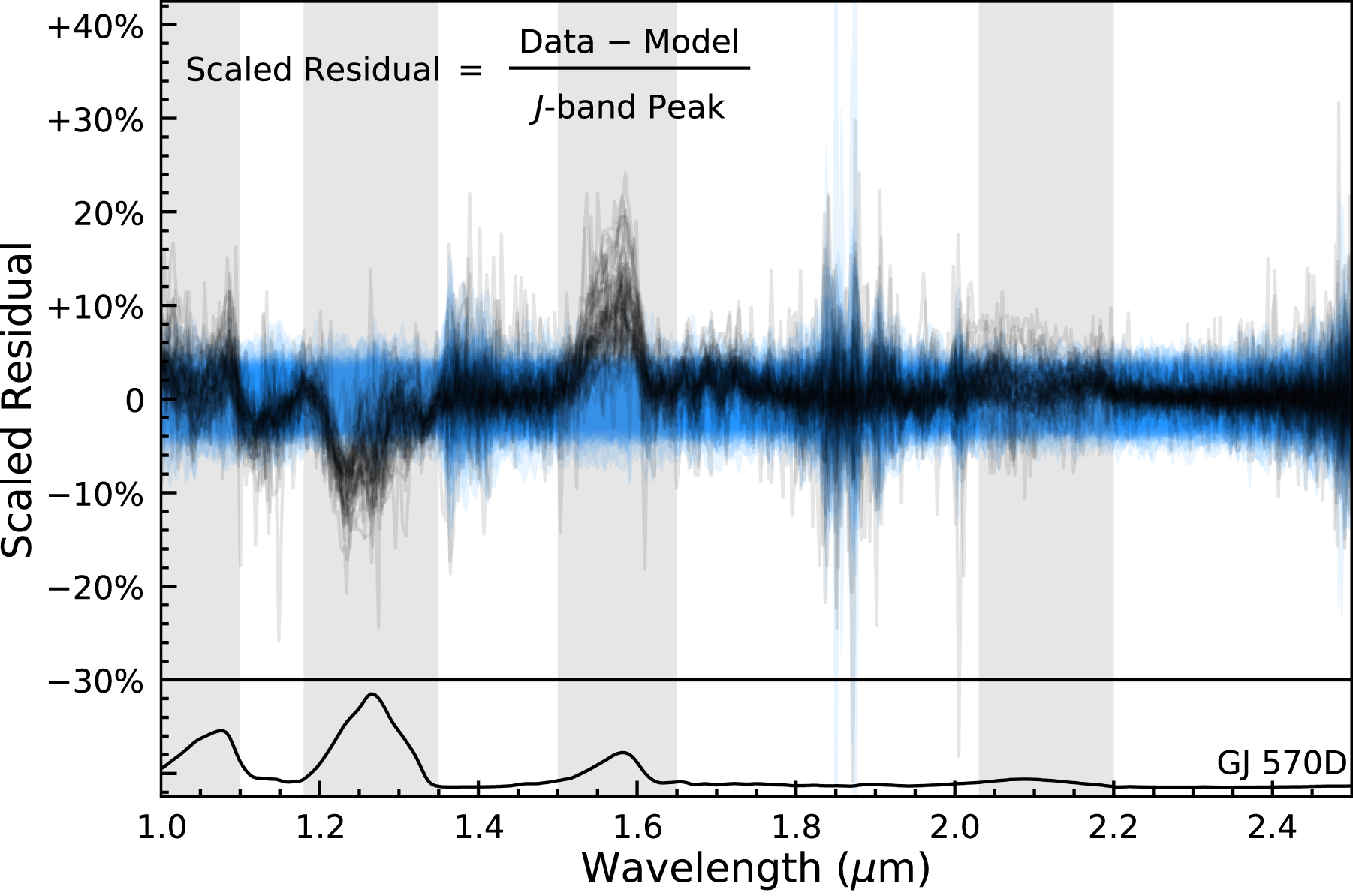
- Paper III: Testing BT-Settl Models --- An Ensemble of 90 Late-M and L Dwarfs (Hurt, Liu, Zhang et al. 2024, ApJ, 961, 121)
Uniform Forward-modeling Analysis of Ultracool Dwarfs. III. Late-M and L Dwarfs in Young Moving Groups, the Pleiades, and the Hyades
Abstract
We present a uniform forward-modeling analysis of 90 late-M and L dwarfs in nearby young (∼10–200Myr) moving groups, the Pleiades, and the Hyades using low-resolution (R ≈ 150) near-infrared (0.9–2.4 μm) spectra and the BT-Settl model atmospheres. We derive the objects’ effective temperatures, surface gravities, radii, and masses by comparing our spectra to the models using a Bayesian framework with nested sampling and calculate the same parameters using evolutionary models. Assuming the evolutionary-based parameters are more robust, our spectroscopically inferred parameters from BT-Settl exhibit two types of systematic behavior for objects near the M-L spectral type boundary. Several objects are clustered around Teff ≈ 1800 K and 5.5 dex, implying impossibly large masses (150–1400 MJup), while others are clustered around Teff >~ 3000 K and log g ~ 3.0 dex, implying unphysically low masses and unreasonably young ages. We find the fitted BT-Settl model spectra tend to overpredict the peak J- and H-band flux for objects located near the M-L boundary, suggesting the dust content included in the model atmospheres is insufficient to match the observations. By adding an interstellar medium–like reddening law to the BT-Settl model spectra, we find the fits between models and observed spectra are greatly improved, with the largest reddening coefficients occurring at the M-L transition. This work delivers a systematic examination of the BT-Settl model atmospheres and constitutes the largest spectral analysis of benchmark late-Mand L-type brown dwarfs to date.


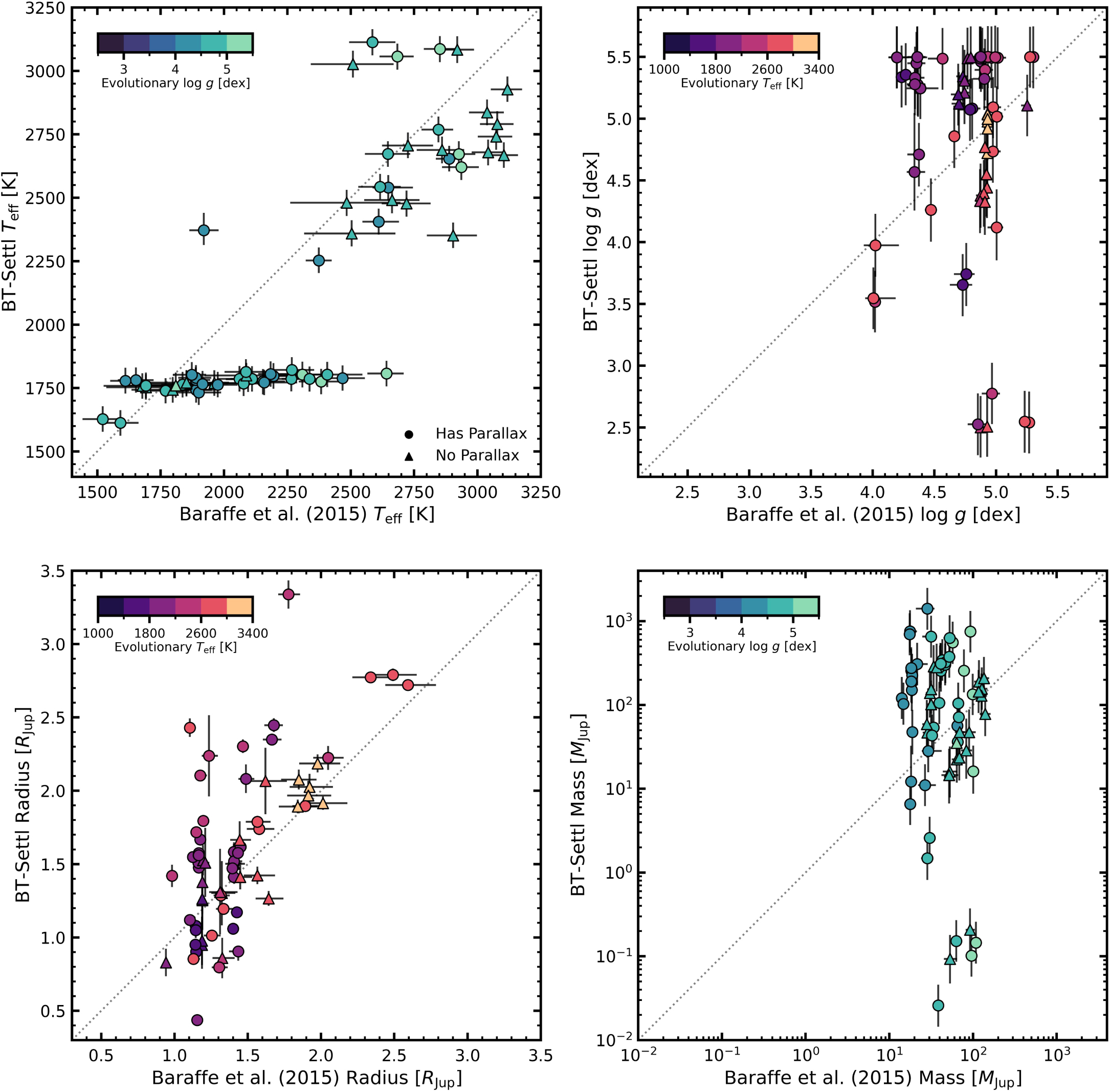
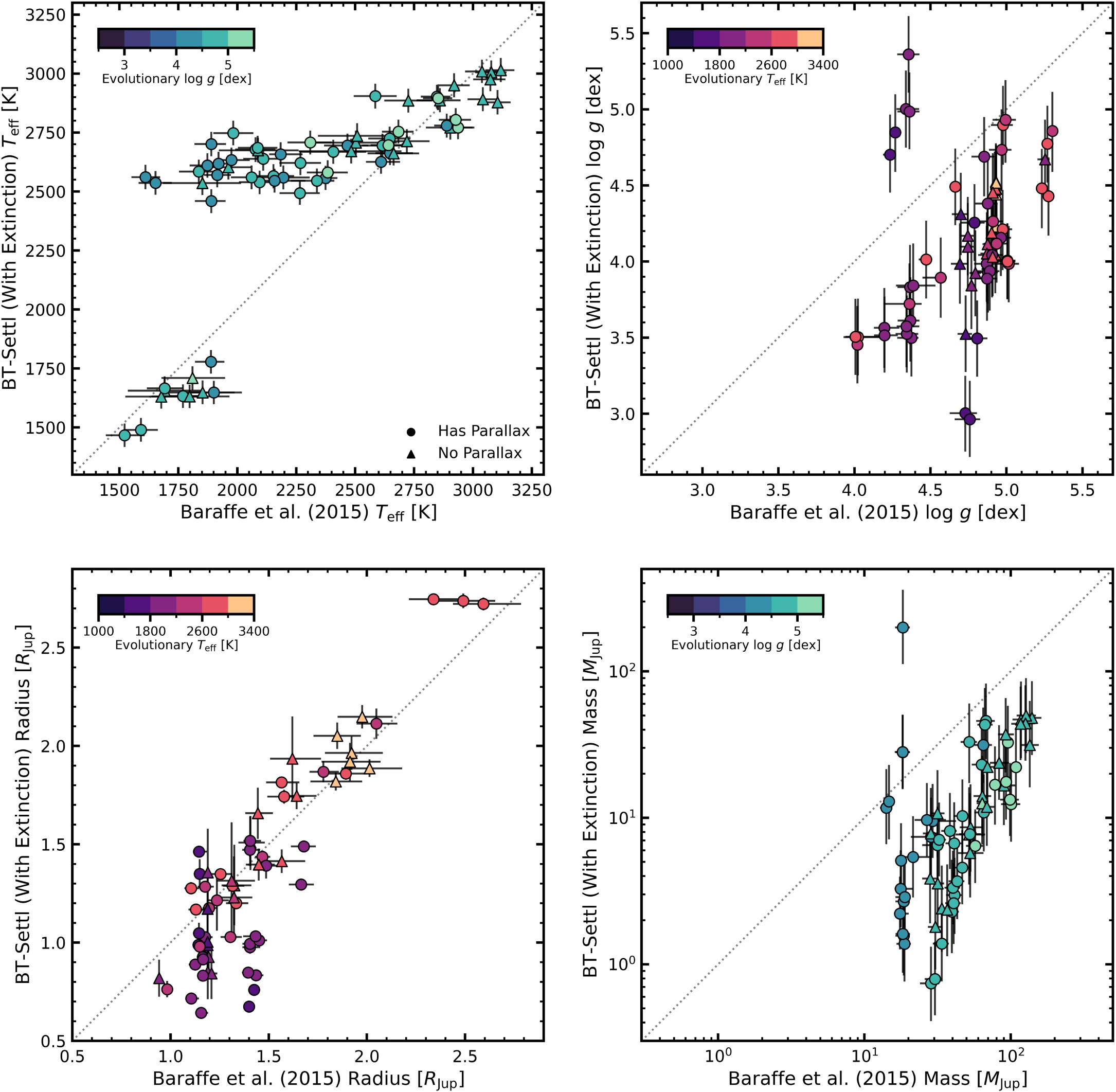
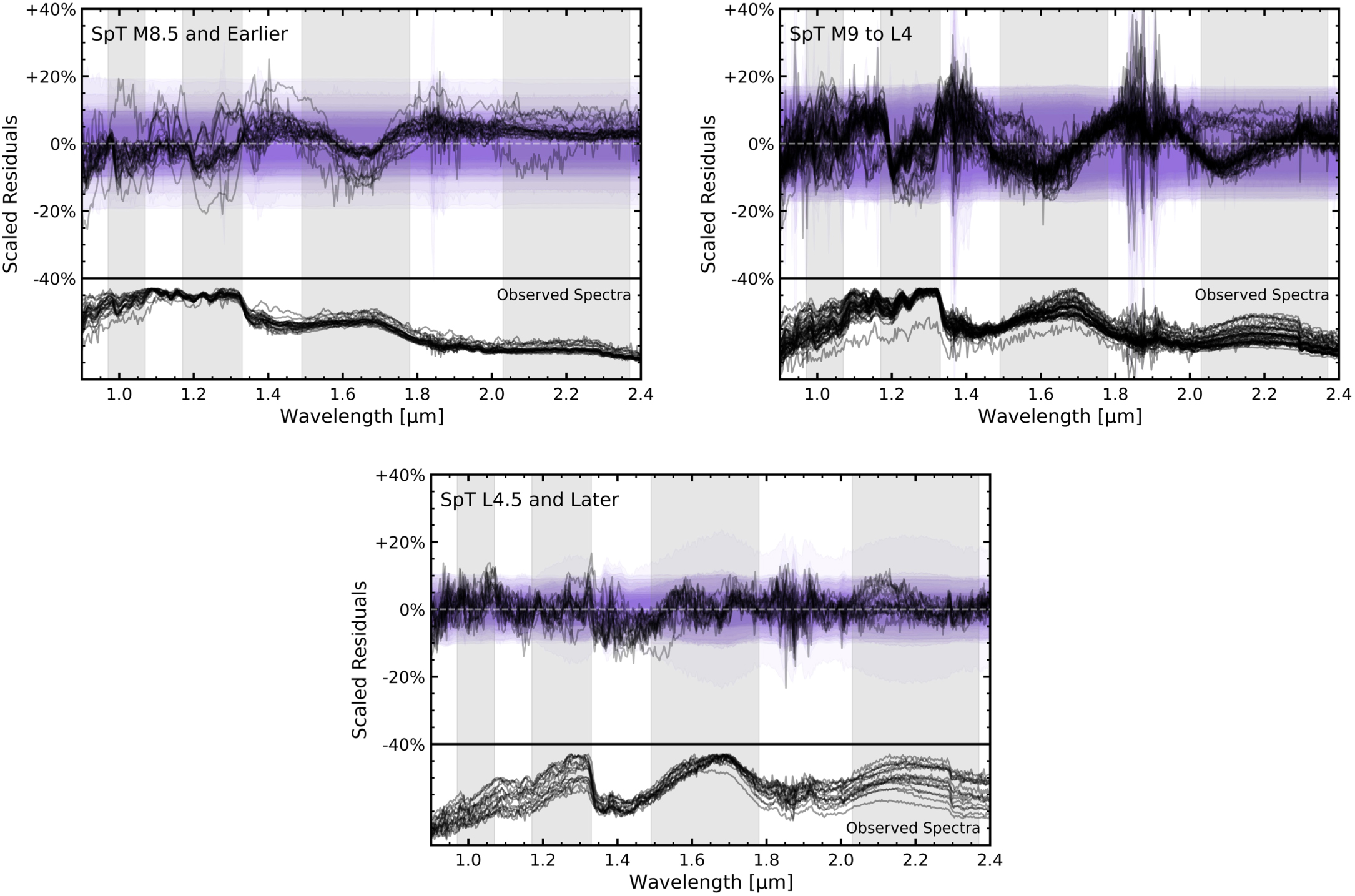


- Paper IV: Anchoring Sonora Diamondback and Saumon & Marley Models --- An Ensemble of 140 Benchmark late-M/L/T Dwarfs (Mader, Zhang et al. in prep)
Uniform Forward-Modeling Analysis of Ultracool Dwarfs. IV. Benchmark Brown Dwarfs and Planetary-Mass Objects Across the Late-M–L–T Spectral Sequence
Abstract
TBA
COCONUTS (COol Companions ON Ultrawide orbiTS)
COCONUTS is a dedicated survey designed to discover exoplanets and brown dwarfs that orbit nearby stars as wide-separation companions. Targeting 300,000 Gaia stars within 100 pc, the program searches for companions by combining multi-wavelength photometry and multi-epoch astrometry from major wide-field digital sky surveys, including Pan-STARRS1, 2MASS, UKIDSS, AllWISE, and CatWISE. To confirm companionship and characterize the ultracool nature of these discoveries, we conducted astrometric, photometric, and spectroscopic follow-up observations with ground-based facilities such as IRTF, Gemini, CFHT, and UKIRT.
- COCONUTS Paper I: Mid-T Brown Dwarf Orbiting an Old White Dwarf (Zhang et al. 2020, ApJ, 891, 171)
COol Companions ON Ultrawide orbiTS (COCONUTS). I. A High-gravity T4 Benchmark around an Old White Dwarf and a Re-examination of the Surface-gravity Dependence of the L/T Transition
Abstract
We present the first discovery from the COol Companions ON Ultrawide orbiTS (COCONUTS) program, a large-scale survey for wide-orbit planetary and substellar companions. We have discovered a comoving system COCONUTS-1, composed of a hydrogen-dominated white dwarf (PSO J058.9855+45.4184; d = 31.5 pc) and a T4 companion (PSO J058.9869+45.4296) at a 40 6 (1280 au) projected separation. We derive physical properties for COCONUTS-1B from (1) its near-infrared spectrum using cloudless Sonora atmospheric models, and (2) its luminosity and the white dwarf’s age (7.3 +2.8/-1.6 Gyr) using Sonora evolutionary models. The two methods give consistent temperatures and radii, but atmospheric models infer a lower surface gravity and therefore an unphysically young age. Assuming evolutionary model parameters (Teff = 1255 +6/-8 K, log g = 5.44 +0.02/-0.03 dex, R = 0.789 +0.011/-0.05 RJup), we find that cloudless model atmospheres have brighter Y- and J-band fluxes than the data, suggesting that condensate clouds have not fully dispersed around 1300K. The W2 flux (4.6 μm) of COCONUTS-1B is fainter than models, suggesting non-equilibrium mixing of CO. To investigate the gravity dependence of the L/T transition, we compile all 60 known L6−T6 benchmarks and derive a homogeneous set of temperatures, surface gravities, and masses. As is well known, young, low-gravity late-L dwarfs have significantly fainter, redder near-infrared photometry and ≈200–300 K cooler temperatures than old, high-gravity objects. Our sample now reveals such gravity dependence becomes weaker for T dwarfs, with young objects having comparable near- infrared photometry and ≈100 K cooler temperatures compared to old objects. Finally, we find that young objects have a larger amplitude J-band brightening than old objects, and also brighten at H band as they cross the L/T transition.
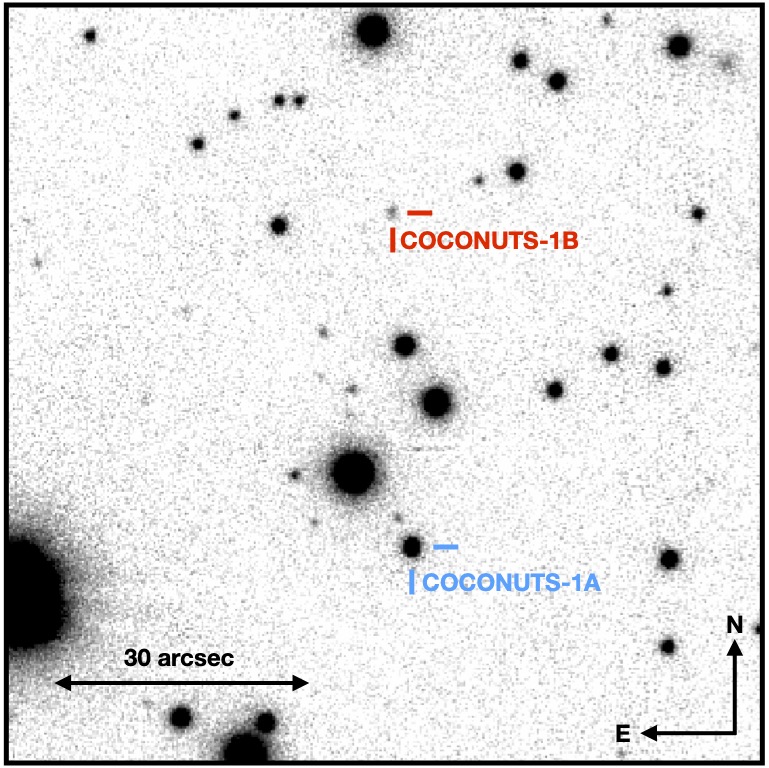
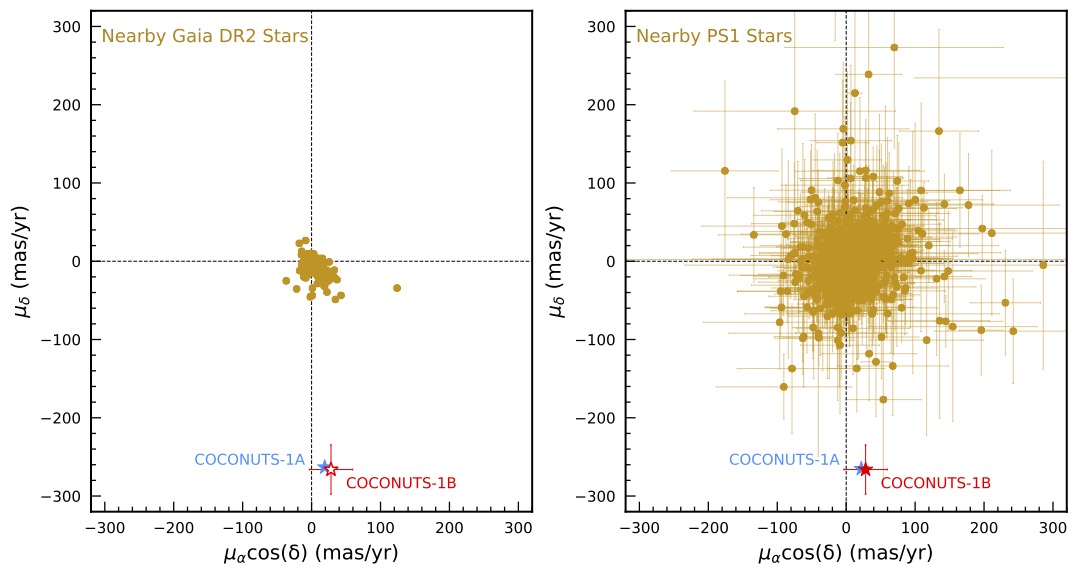
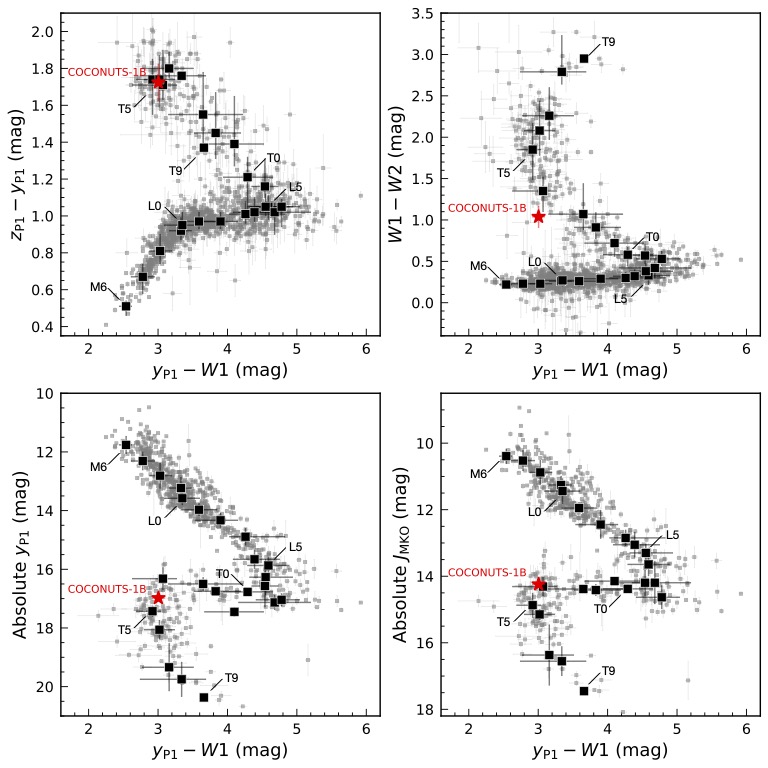
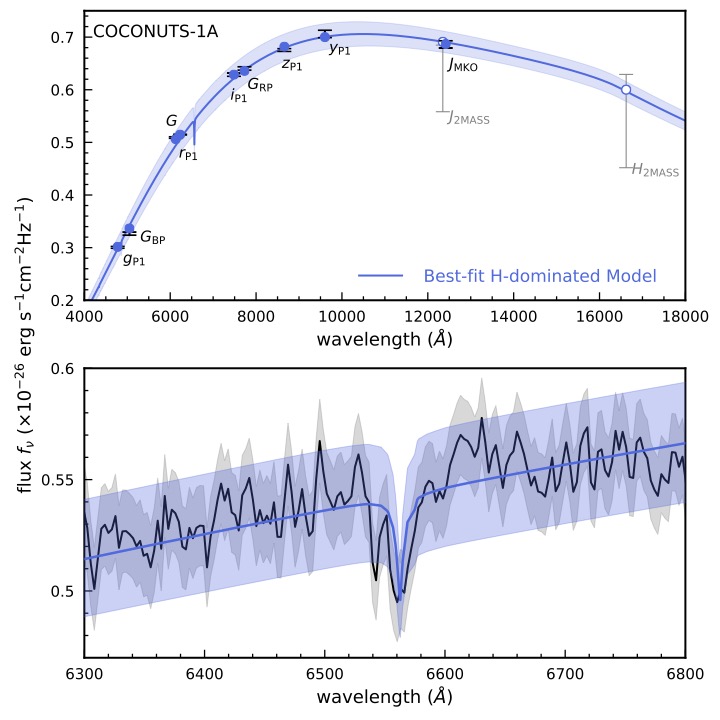
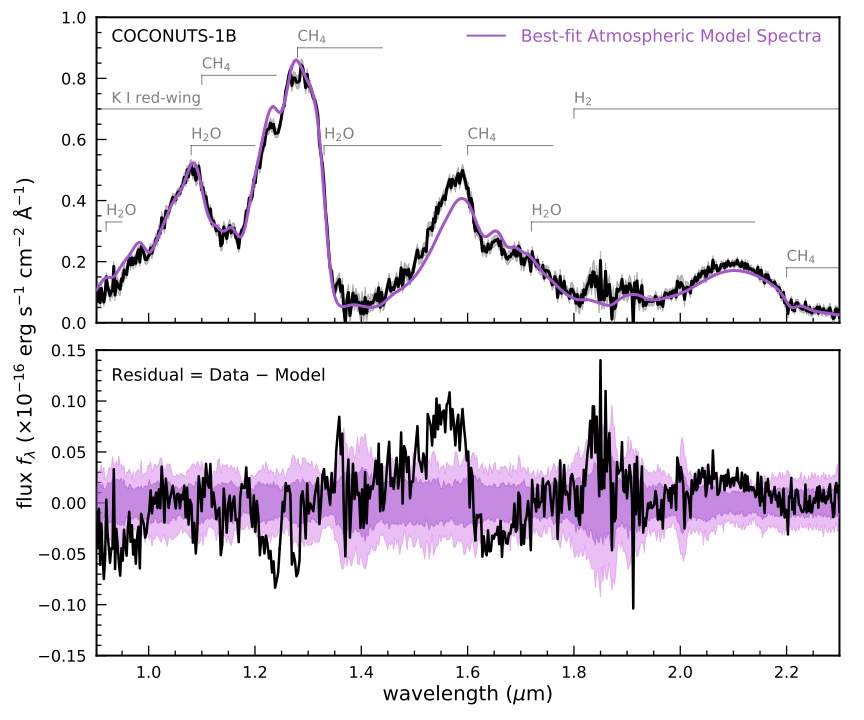
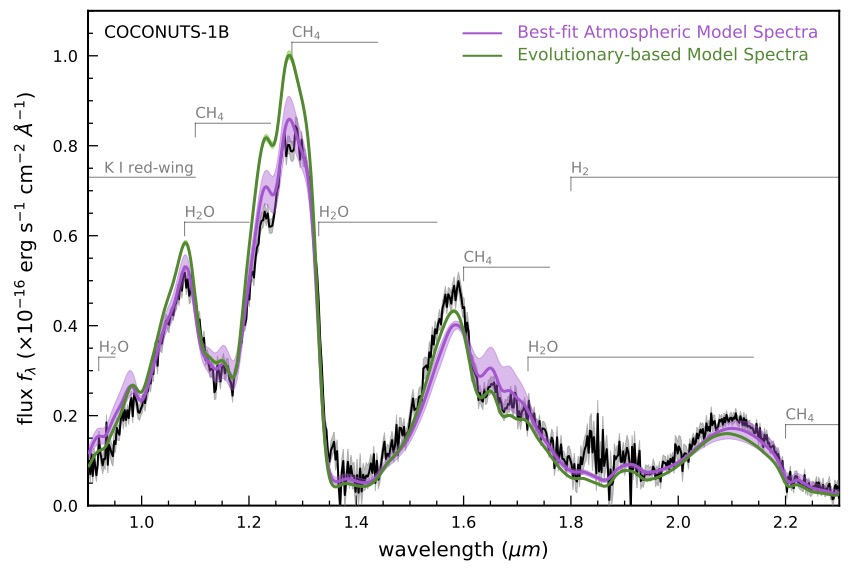
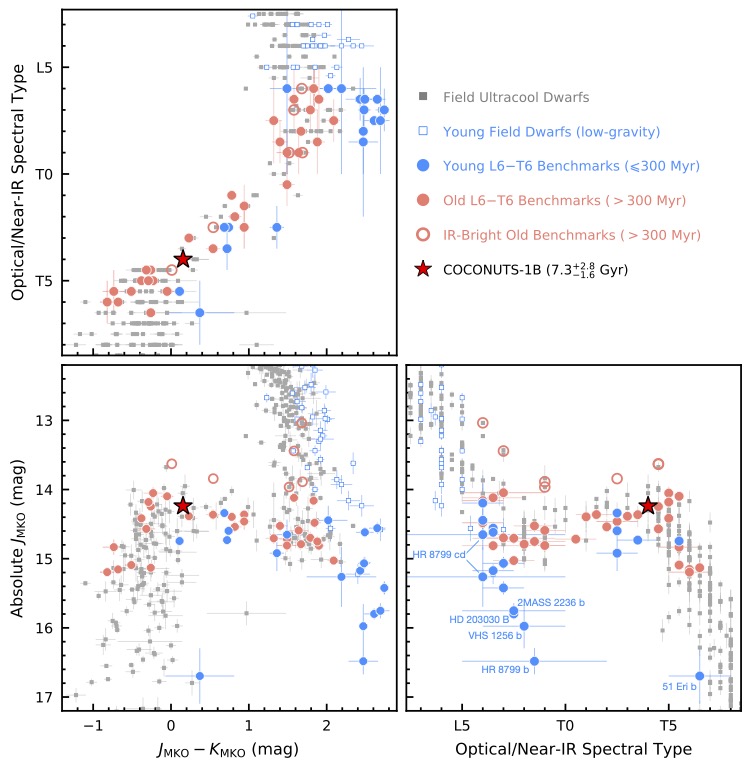

- COCONUTS Paper II: T/Y Planetary-mass Companion Orbiting a Young M Star (Zhang et al. 2021d, ApJ, 916, 11)
The Second Discovery from the COCONUTS Program: A Cold Wide-orbit Exoplanet around a Young Field M Dwarf at 10.9 pc
Abstract
We present the identification of the second discovery from the COol Companions ON Ultrawide orbiTS (COCONUTS) program, the COCONUTS-2 system, composed of the M3 dwarf L 34-26 and the T9 dwarf WISEPA J075108.79−763449.6. Given their common proper motions and parallaxes, these two field objects constitute a physically bound pair with a projected separation of 594′′ (6471au). The primary star COCONUTS-2A has strong stellar activity (Hα, X-ray, and ultraviolet emission) and is rapidly rotating (Prot = 2.83 days), from which we estimate an age of 150–800 Myr. Comparing equatorial rotational velocity derived from the Transiting Exoplanet Survey Satellite (TESS) light curve to spectroscopic vsini, we find that COCONUTS-2A has a nearly edge-on inclination. The wide exoplanet COCONUTS-2b has an effective temperature of Teff = 434 ± 9 K, a surface gravity of log g = 4.11 +0.11/-0.18 dex, and a mass of M = 6.3 +1.5/-1.9 MJup based on hot-start evolutionary models, leading to a mass ratio of 0.016+0.004 for the COCONUTS-2 system. COCONUTS-2b is the second coldest (after WD 0806−661B), and the second widest (after TYC 9486-927-1 b) exoplanet imaged to date. Comparison of COCONUTS-2b’s infrared photometry with ultracool model atmospheres suggests the presence of both condensate clouds and non-equilibrium chemistry in its photosphere. Similar to 51 Eri b, COCONUTS-2b has a sufficiently low luminosity (log(Lbol/Lsun) = -6.384 ± 0.028 dex) to be consistent with the cold-start process that may form gas-giant (exo)planets, though its large separation means that such formation would not have occurred in situ. Finally, at a distance of 10.9 pc, COCONUTS-2b is the nearest imaged exoplanet to Earth known to date.
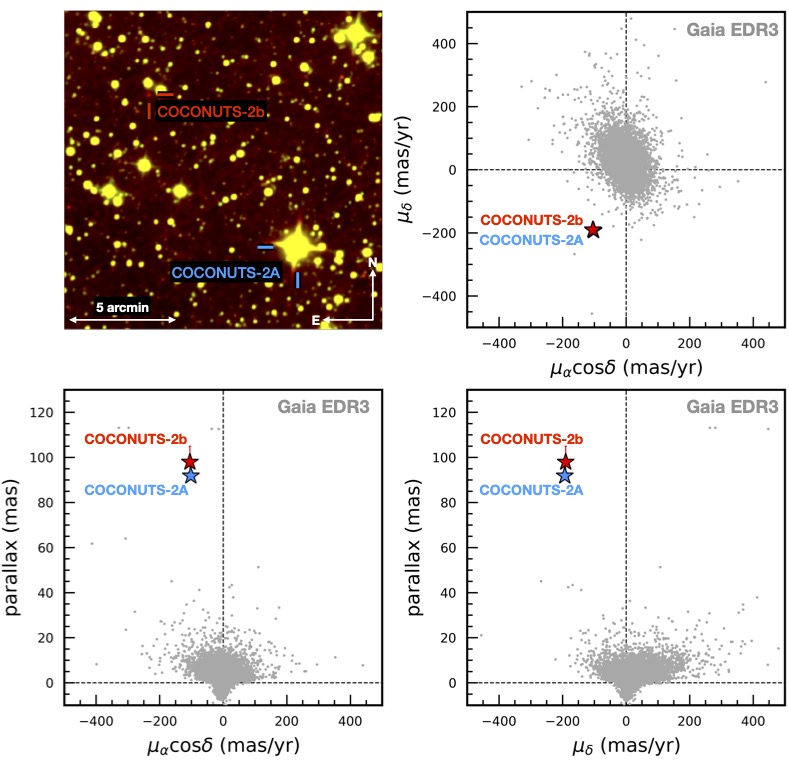
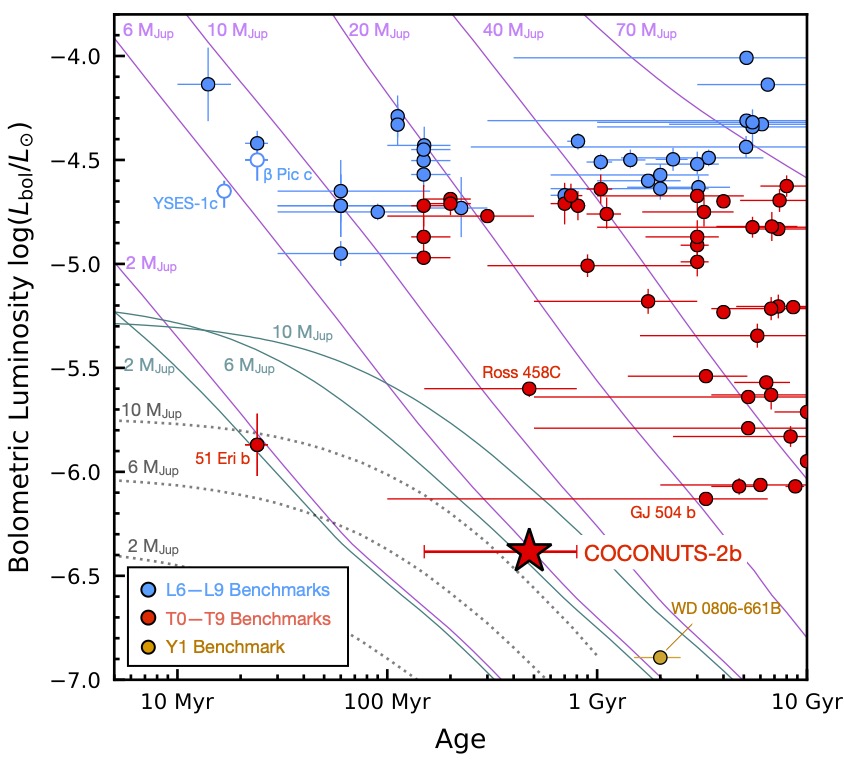

- COCONUTS Paper III: Late-L Brown Dwarf Orbiting a Young M Star (Zhang et al. 2022, ApJ, 935, 15)
COol Companions ON Ultrawide orbiTS (COCONUTS). III. A Very Red L6 Benchmark Brown Dwarf around a Young M5 Dwarf
Abstract
We present the third discovery from the COol Companions ON Ultrawide orbiTS (COCONUTS) program, the COCONUTS-3 system, composed of the young M5 primary star UCAC4 374−046899 and the very red L6 dwarf WISEA J081322.19−152203.2. These two objects have a projected separation of 61¢¢ (1891 au) and are physically associated given their common proper motions and estimated distances. The primary star, COCONUTS-3A, has a mass of 0.123 ± 0.006 Me, and we estimate its age as 100 Myr to 1 Gyr based on its stellar activity (via Hα and X-ray emission), kinematics, and spectrophotometric properties. We derive its bulk metallicity as 0.21 ± 0.07 dex using empirical calibrations established by older and higher-gravity M dwarfs and find that this [Fe/H] could be slightly underestimated according to PHOENIX models given COCONUTS-3A’s younger age. The companion, COCONUTS-3B, has a near-infrared spectral type of L6 ± 1 INT-G, and we infer physical properties of Teff = 1362 +48/-73 K, log(g) = 4.96 +0.15/-0.34 dex, R = 1.03 +0.12/-0.06 RJup, and M = 39 +11/-18 MJup using its bolometric luminosity, its host star’s age, and hot-start evolution models. We construct cloudy atmospheric model spectra at the evolution- based physical parameters and compare them to COCONUTS-3B’s spectrophotometry. We find that this companion possesses ample condensate clouds in its photosphere (fsed = 1) with the data–model discrepancies likely due to the models using an older version of the opacity database. Compared to field-age L6 dwarfs, COCONUTS-3B has fainter absolute magnitudes and a 120 K cooler Teff. Also, the J − K color of this companion is among the reddest for ultracool benchmarks with ages older than a few hundred megayears. COCONUTS-3 likely formed in the same fashion as stellar binaries given the companion-to-host mass ratio of 0.3 and represents a valuable benchmark to quantify the systematics of substellar model atmospheres.
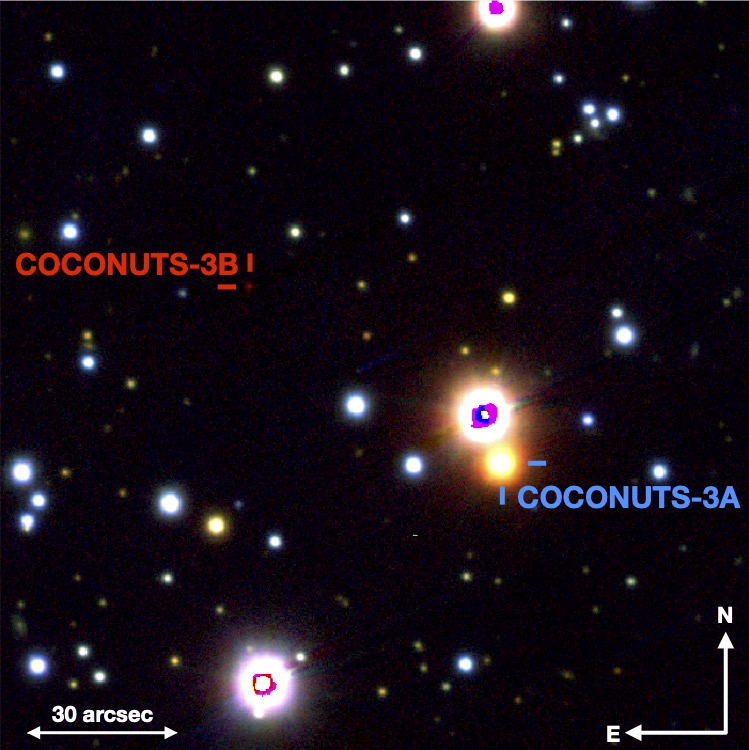
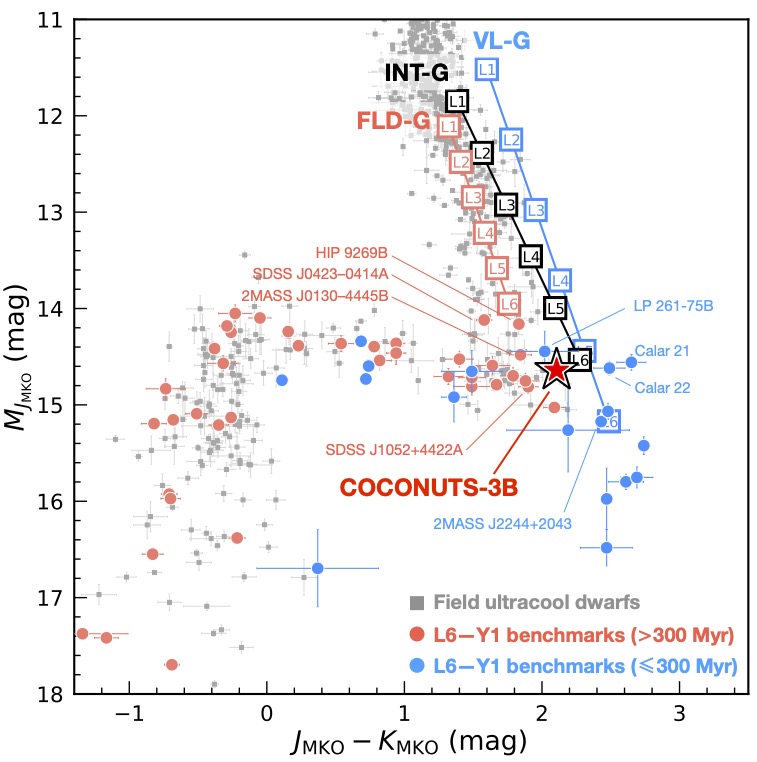
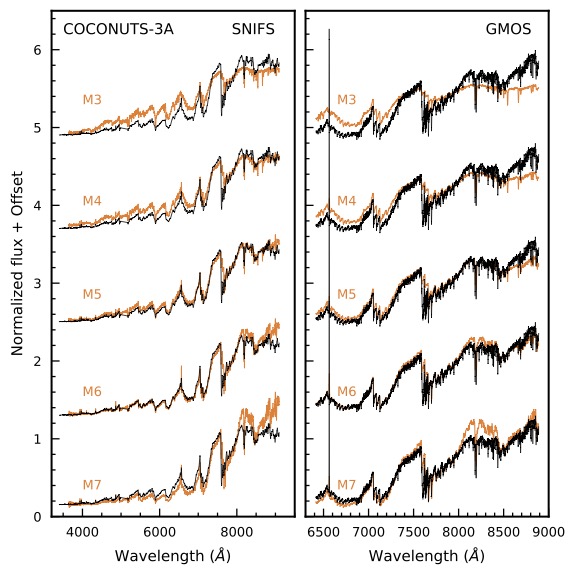
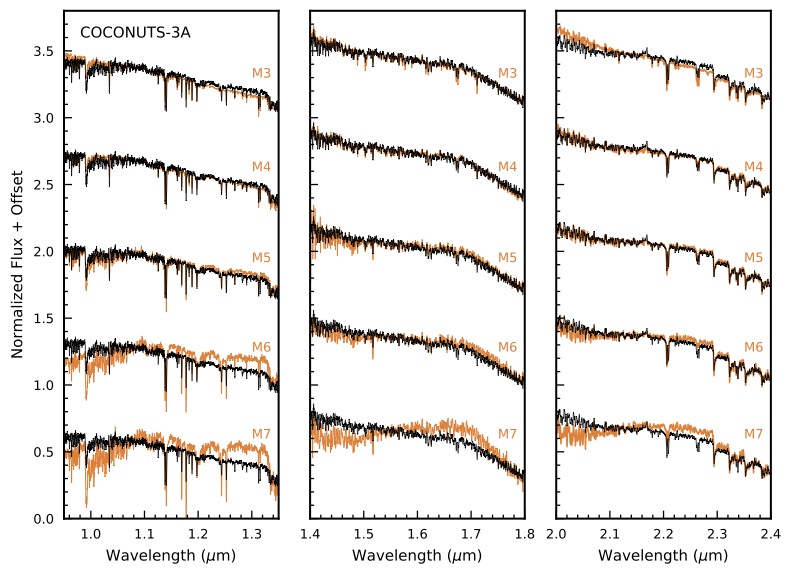
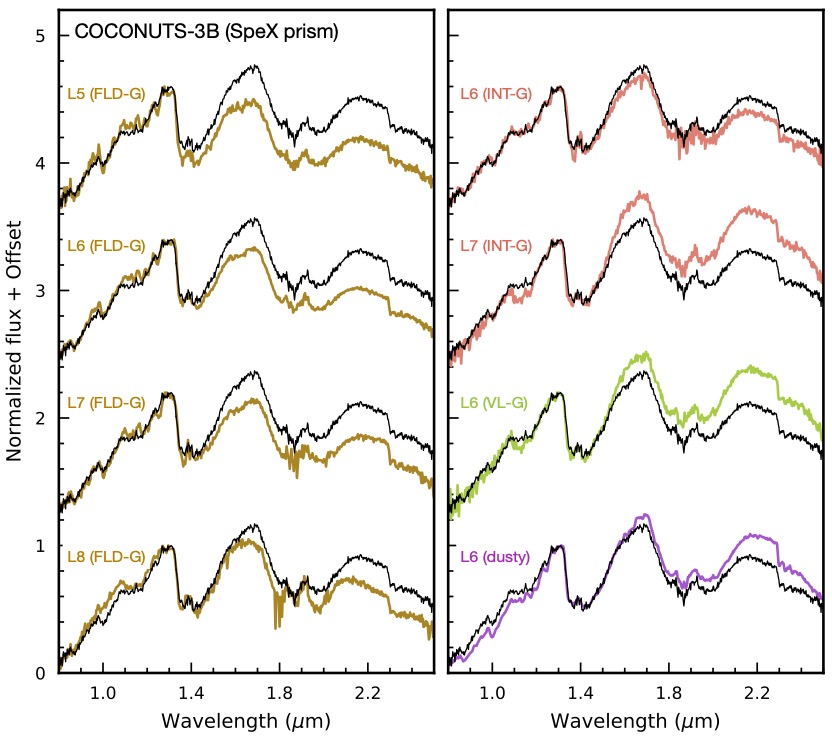
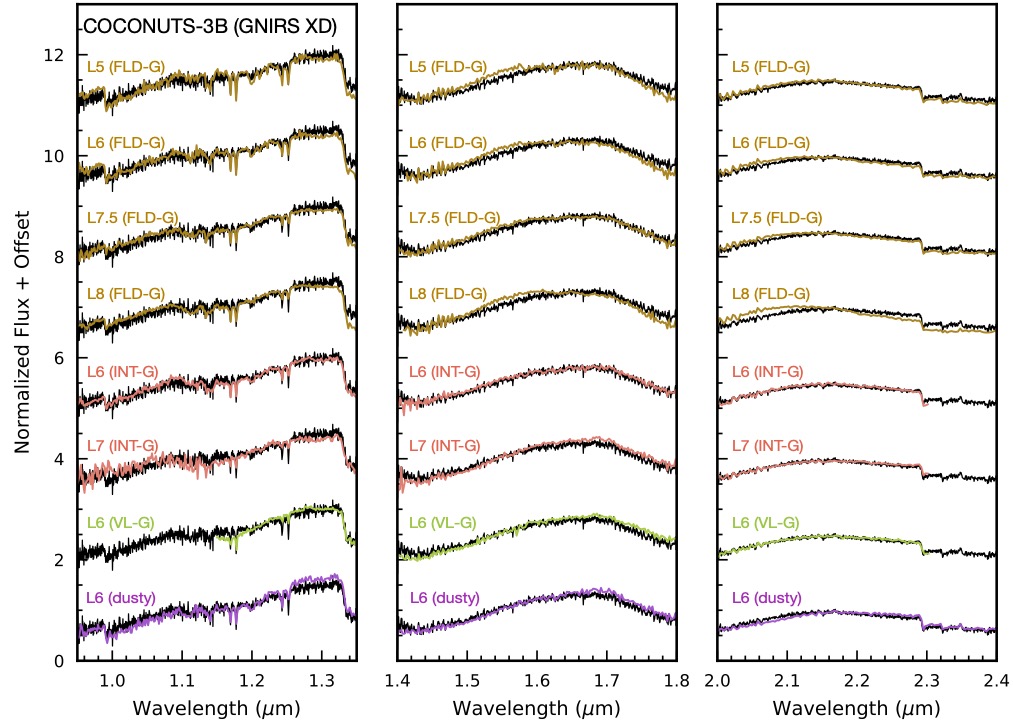
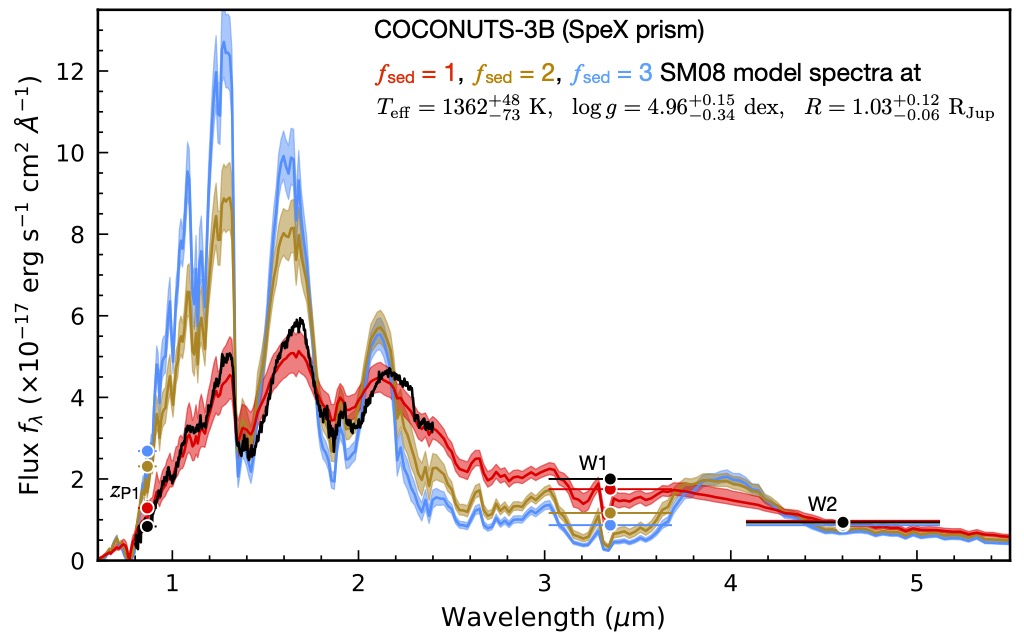
USMILE (Ultracool dwarf Science with Mach Ine LEarning)
USMILE is a program designed to apply machine learning techniques to (1) discover new brown dwarfs and planetary-mass objects through wide-field sky surveys, such as LSST and Euclid, and (2) characterize physical properties of ultracool dwarfs. This program is initiated by myself and my wife, Yanxia Li. We dedicate this work to our daughter, Allison.
- USMILE Paper I: Scalable Tree-based Models for Photometric Spectral Classification and New Discoveries from LSST DP1 and Euclid Q1 (Zhang & Li 2025, AJ, in press)
Ultracool dwarf Science with MachIne LEarning (USMILE). I. Scalable Tree-Based Models for Photometric Spectral Classification and New Discoveries from LSST Data Preview 1 and Euclid Quick Data Release 1
Abstract
We present the Ultracool dwarf Science with MachIne LEarning (USMILE), a program developing machine-learning tools for the discovery and characterization of ultracool dwarfs. We introduce USMILE Avocado, a spectral classification framework that uses broadband photometry from wide-field surveys --- Rubin Observatory LSST Data Preview 1 (DP1), VISTA Hemisphere Survey (VHS), and CatWISE —-- as input features. The framework comprises two gradient-boosted decision-tree models scalable to the massive data volumes of modern surveys: the classifier, which distinguishes ultracool dwarfs from stellar/extragalactic contaminants, and the regressor, which predicts spectral types. A key strength is its ability to natively handle missing photometric features, common in wide-field searches, whereas earlier machine-learning approaches required complete multi-band detections or relied on imputation, thereby excluding genuine ultracool dwarfs or introducing bias. Trained on an augmented labeled dataset of >2 million sources built from known ultracool dwarfs, reddened early-type stars, and quasars, the models achieve strong performance: the classifier attains an ROC AUC of 0.976 and an F1 score of 0.92, while the regressor yields a mean-squared error of 0.88 sub-types. Applying these models, we carried out the first ultracool dwarf search with LSST DP1, cross-matched against VHS and CatWISE. Crucially, Euclid Quick Data Release 1 provided near-infrared spectra for hundreds of candidates, enabling a rare, large-scale external spectroscopic validation. This confirmed 15 M6–L2 discoveries, verified USMILE performance, and clarified regimes where USMILE predictions are most reliable. Building on these insights, we identified 25 additional high-quality M6–L9 photometric candidates. These early discoveries demonstrate the effectiveness of scalable machine-learning methods in the data-rich era of wide-field surveys, highlighting the synergy between LSST and Euclid in expanding the ultracool dwarf census.
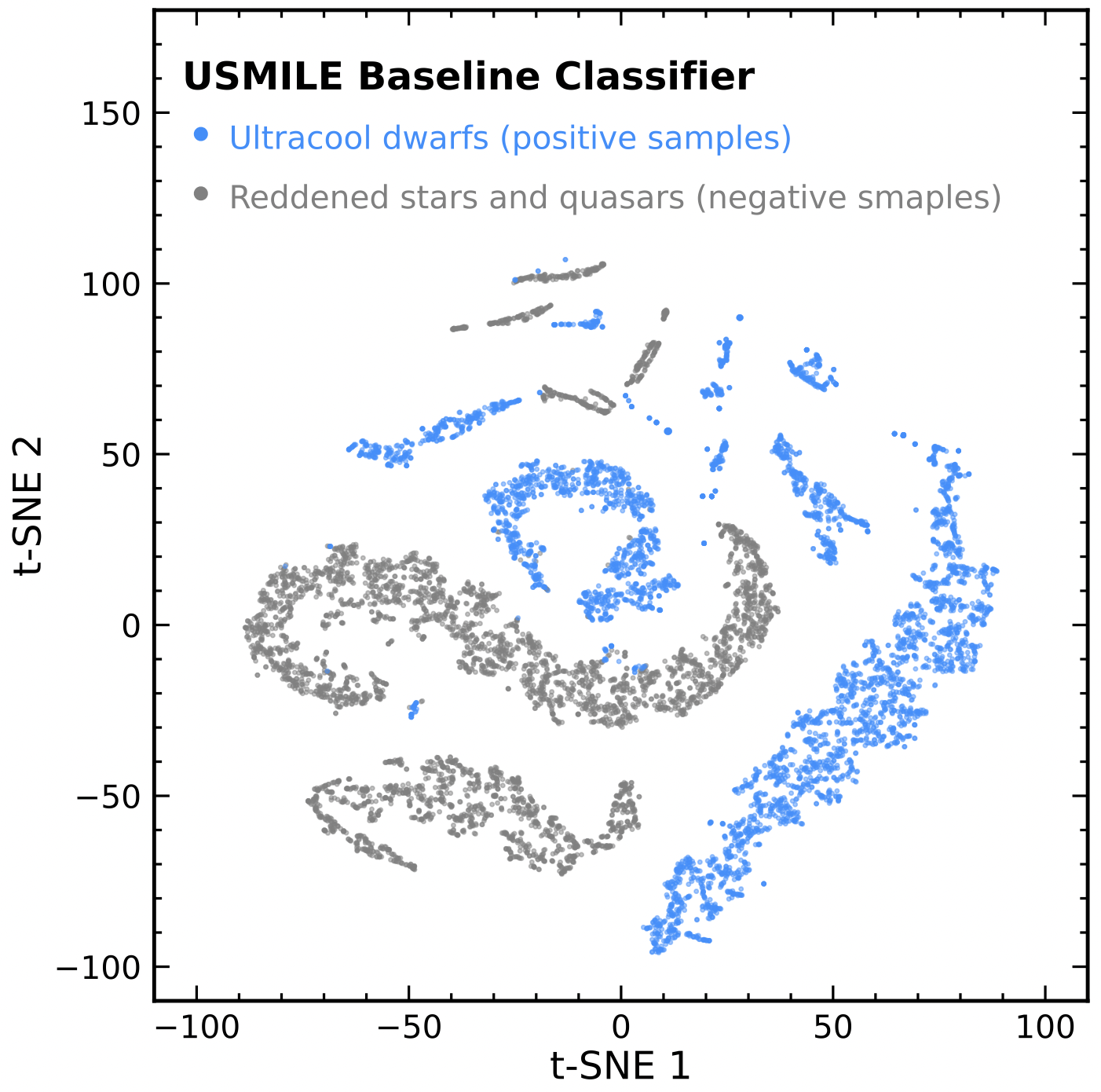
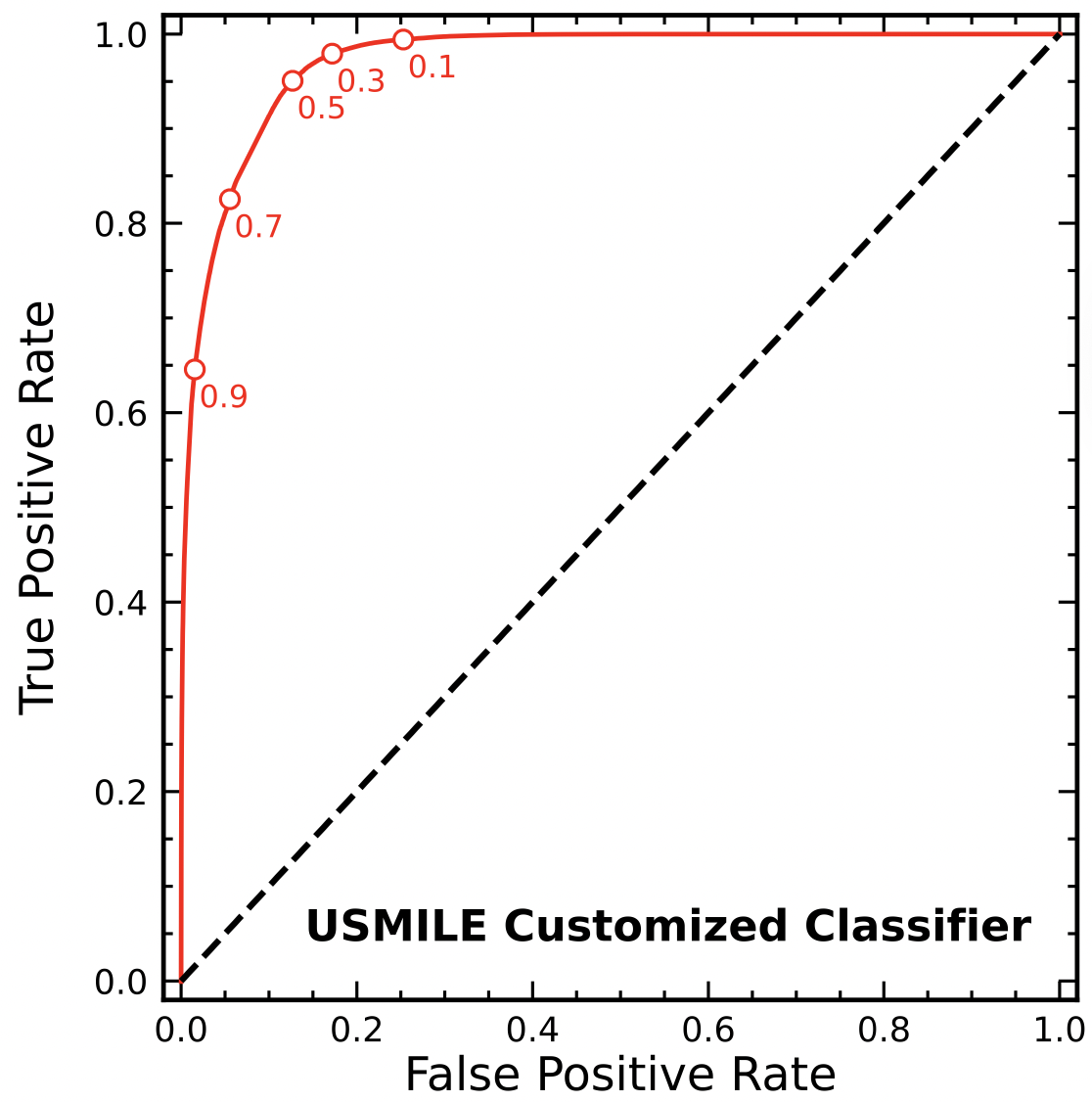
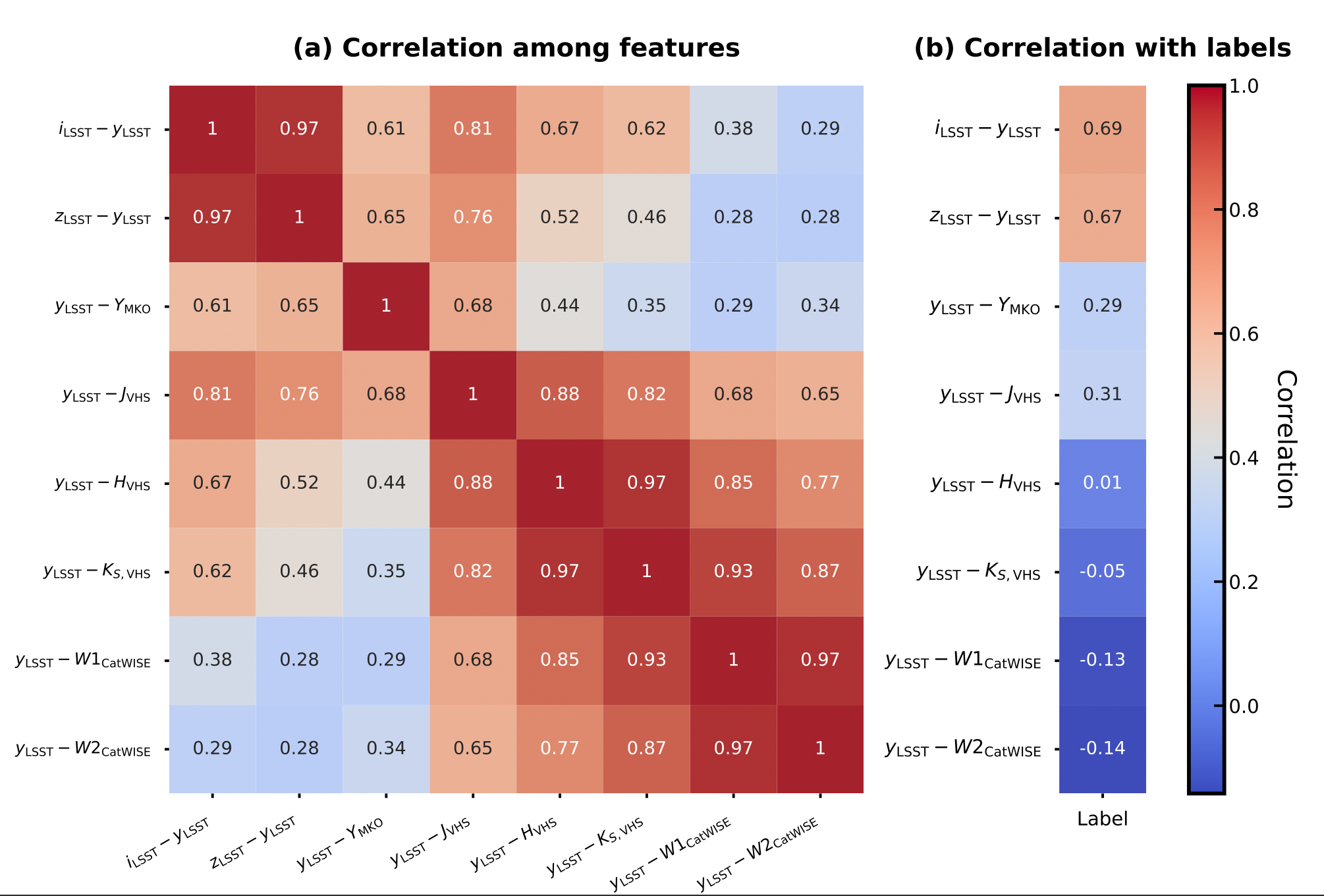
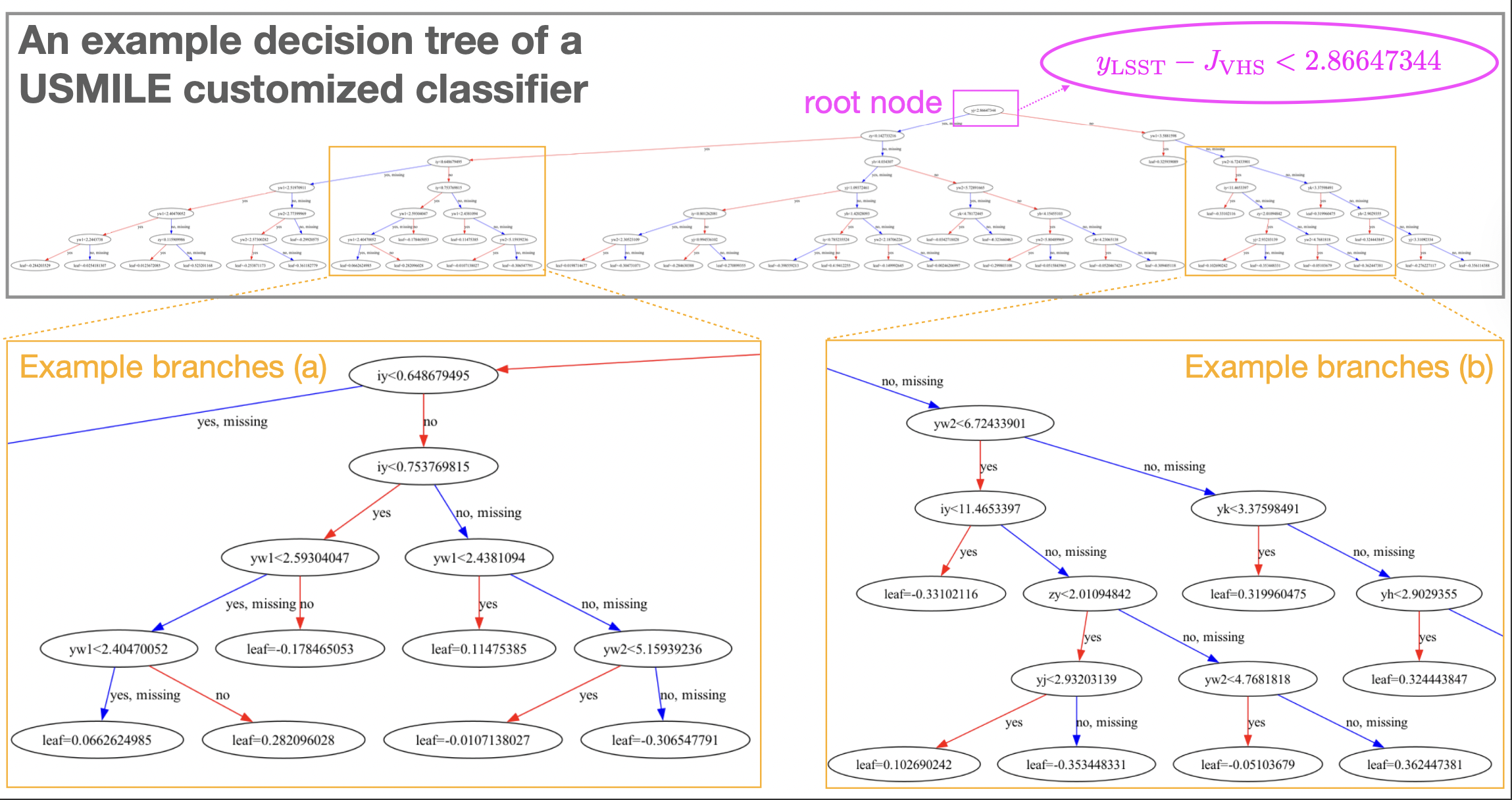
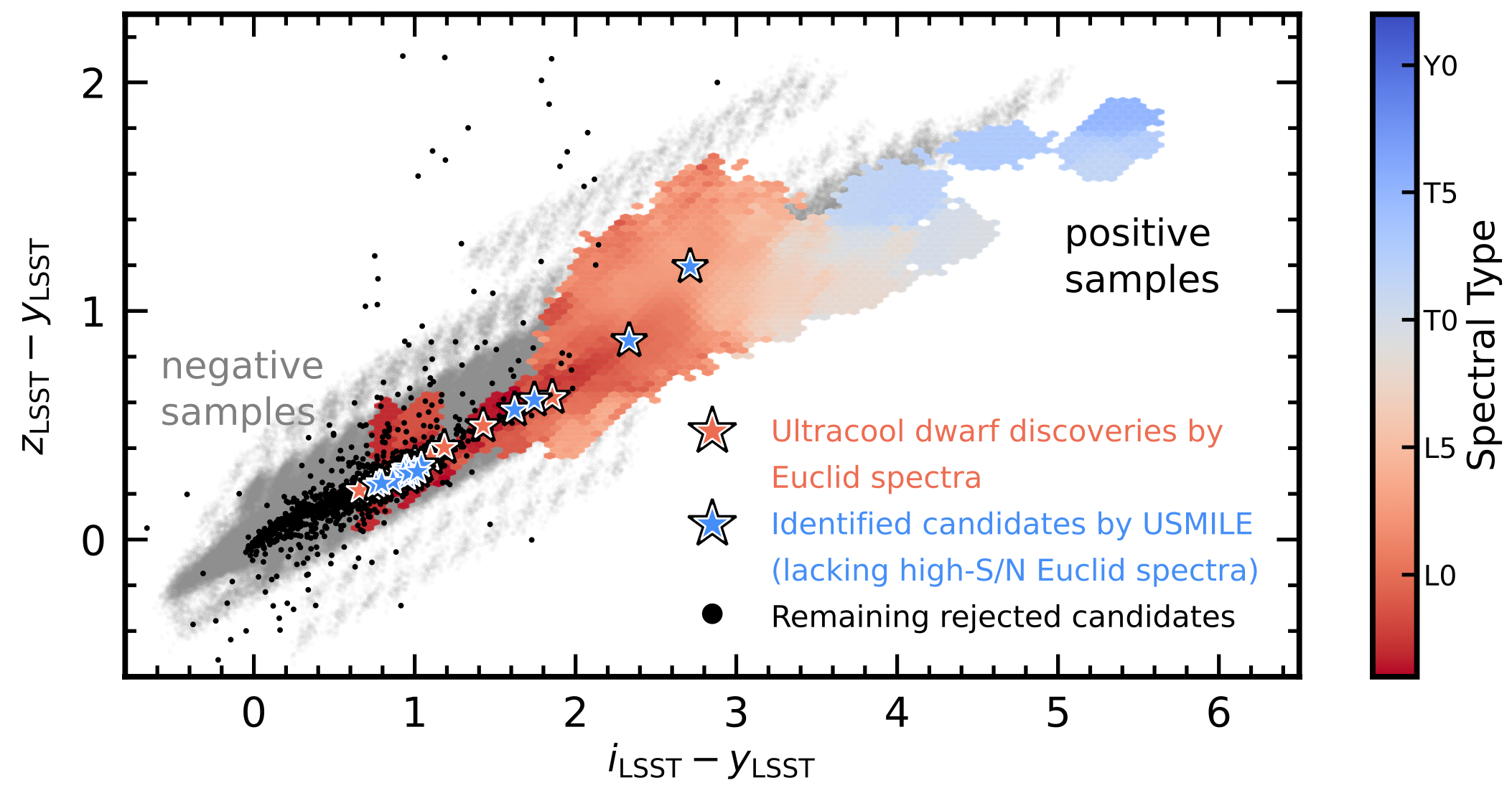
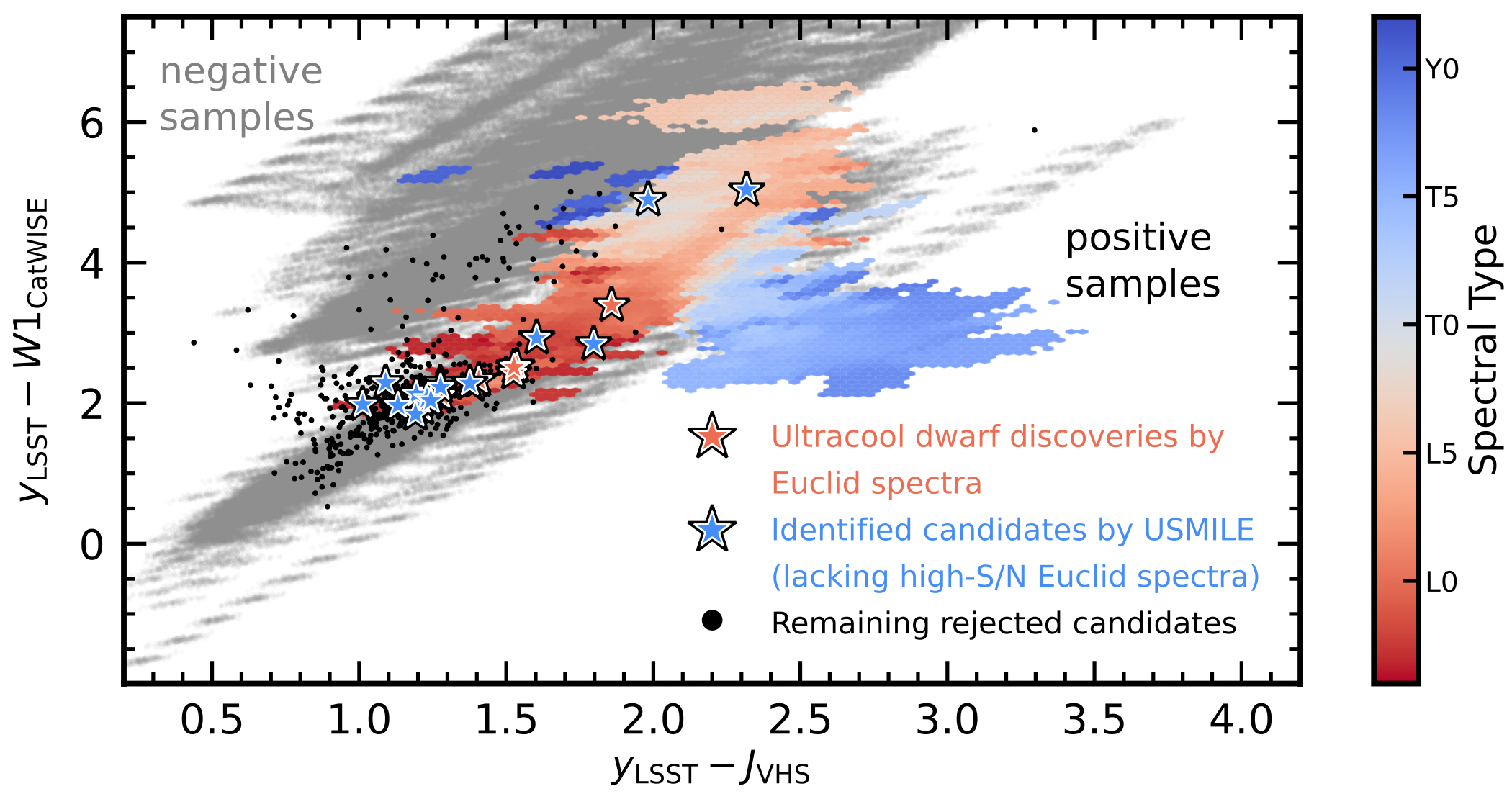
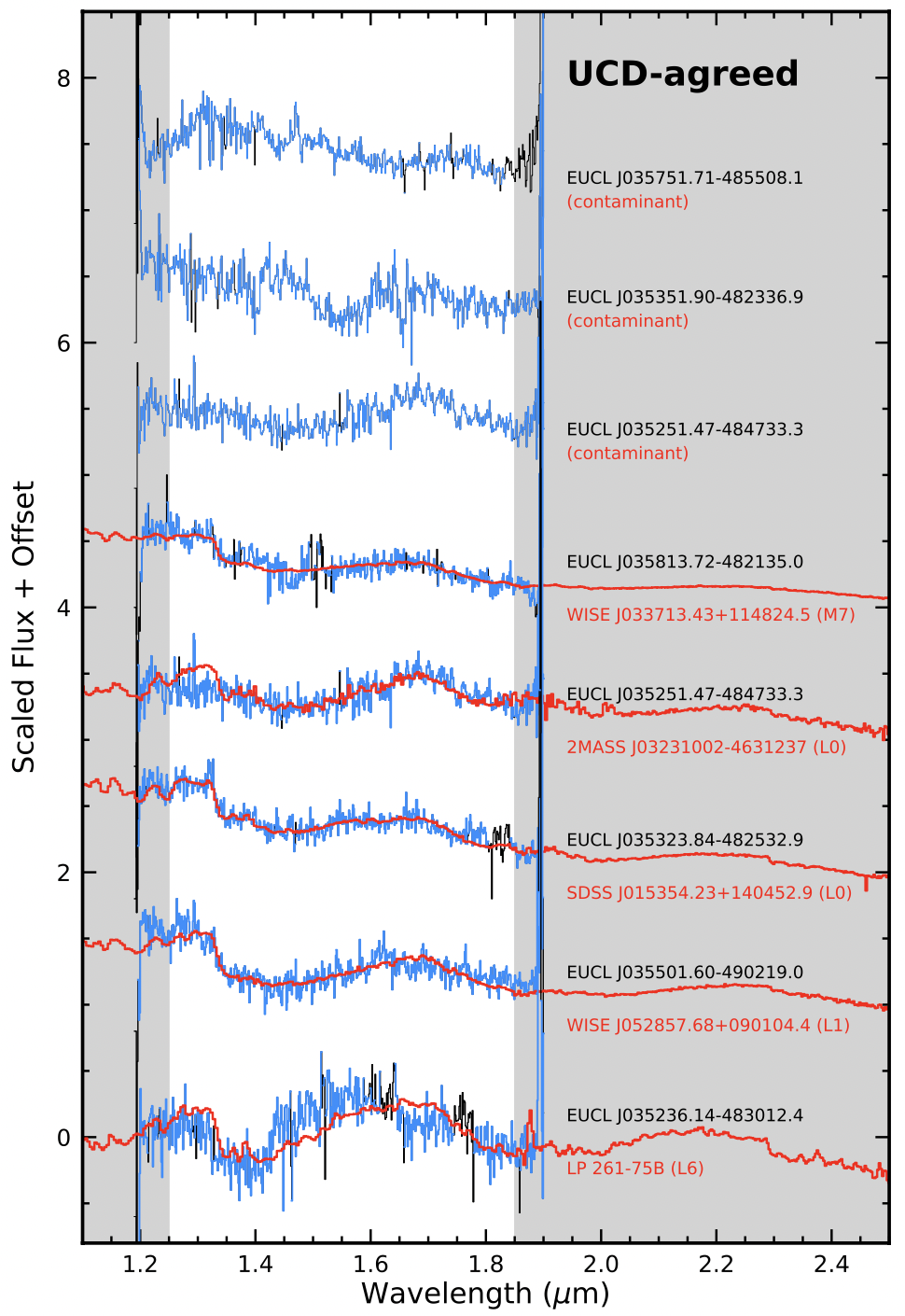
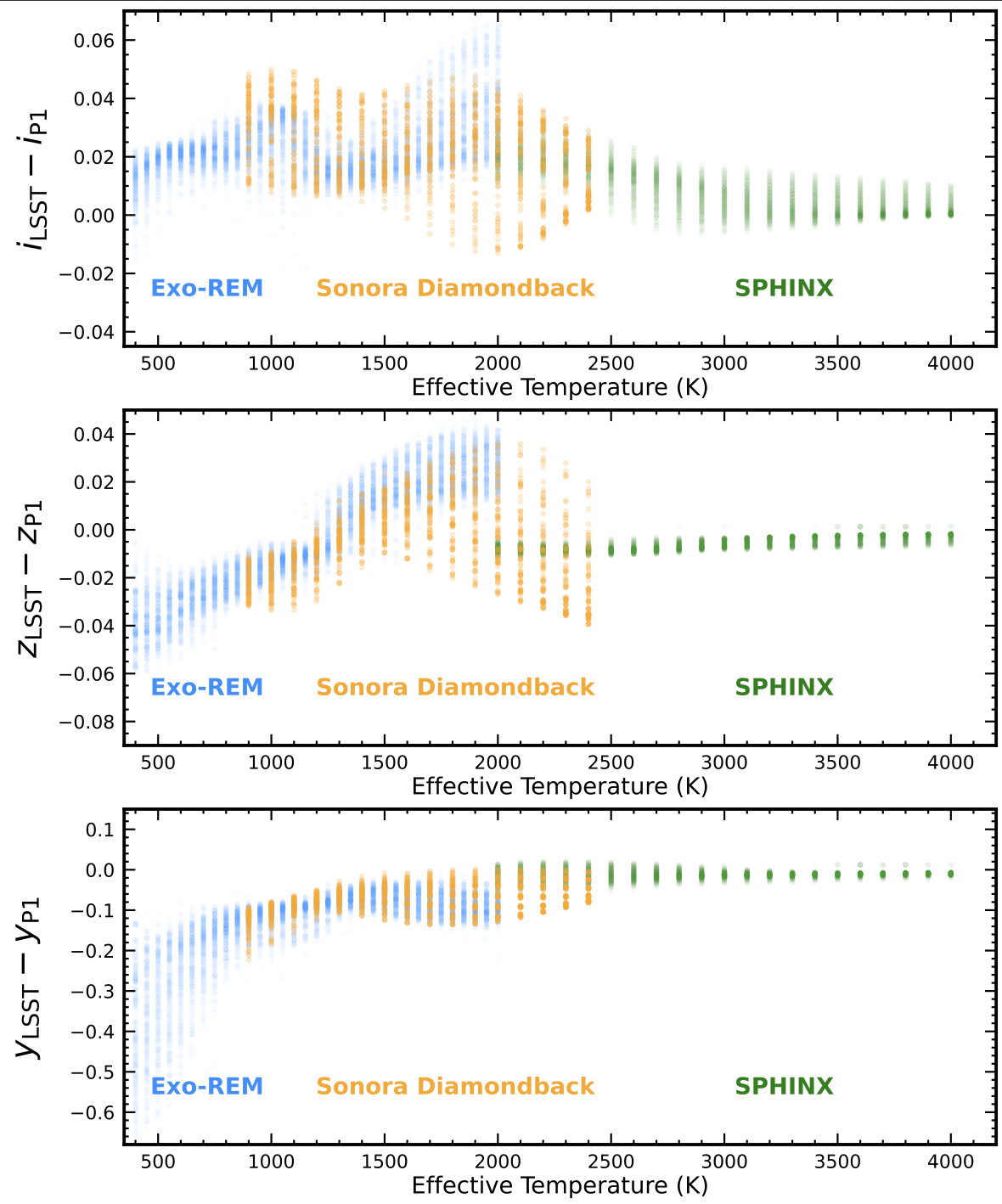
- New Young T Dwarfs in Nearby Young Moving Groups (Zhang et al. 2021a, ApJ, 911, 7)
The Hawaii Infrared Parallax Program. V. New T-dwarf Members and Candidate Members of Nearby Young Moving Groups
Abstract
We present a search for new planetary-mass members of nearby young moving groups (YMGs) using astrometry for 694 T and Y dwarfs, including 447 objects with parallaxes, mostly produced by recent large parallax programs from UKIRT and Spitzer. Using the BANYAN Σ and LACEwING algorithms, we identify 30 new candidate YMG members, with spectral types of T0−T9 and distances of 10 − 43 pc. Some candidates have unusually red colors and/or faint absolute magnitudes compared to field dwarfs with similar spectral types, providing supporting evidence for their youth, including 4 early-T dwarfs. We establish one of these, the variable T1.5 dwarf 2MASS J21392676+0220226, as a new planetary-mass member (14.6 +3.2/-1.6 MJup) of the Carina-Near group (200 ± 50 Myr) based on its full six-dimensional kinematics, including a new parallax measurement from CFHT. The high-amplitude variability of this object is suggestive of a young age, given the coexistence of variability and youth seen in previously known YMG T dwarfs. Our four latest-type (T8−T9) YMG candidates, WISE J031624.35+430709.1, ULAS J130217.21+130851.2, WISEPC J225540.74−311841.8, and WISE J233226.49−432510.6, if confirmed, will be the first free-floating planets (≈ 2 − 6 MJup ) whose ages and luminosities are compatible with both hot-start and cold-start evolutionary models, and thus overlap the properties of the directly-imaged planet 51 Eri b. Several of our early/mid-T candidates have peculiar near-infrared spectra, indicative of heterogenous photospheres or unresolved binarity. Radial velocity measurements needed for final membership assessment for most of our candidates await upcoming 20–30 meter class telescopes. In addition, we compile all 15 known T7−Y1 benchmarks and derive a homogeneous set of their effective temperatures, surface gravities, radii, and masses.

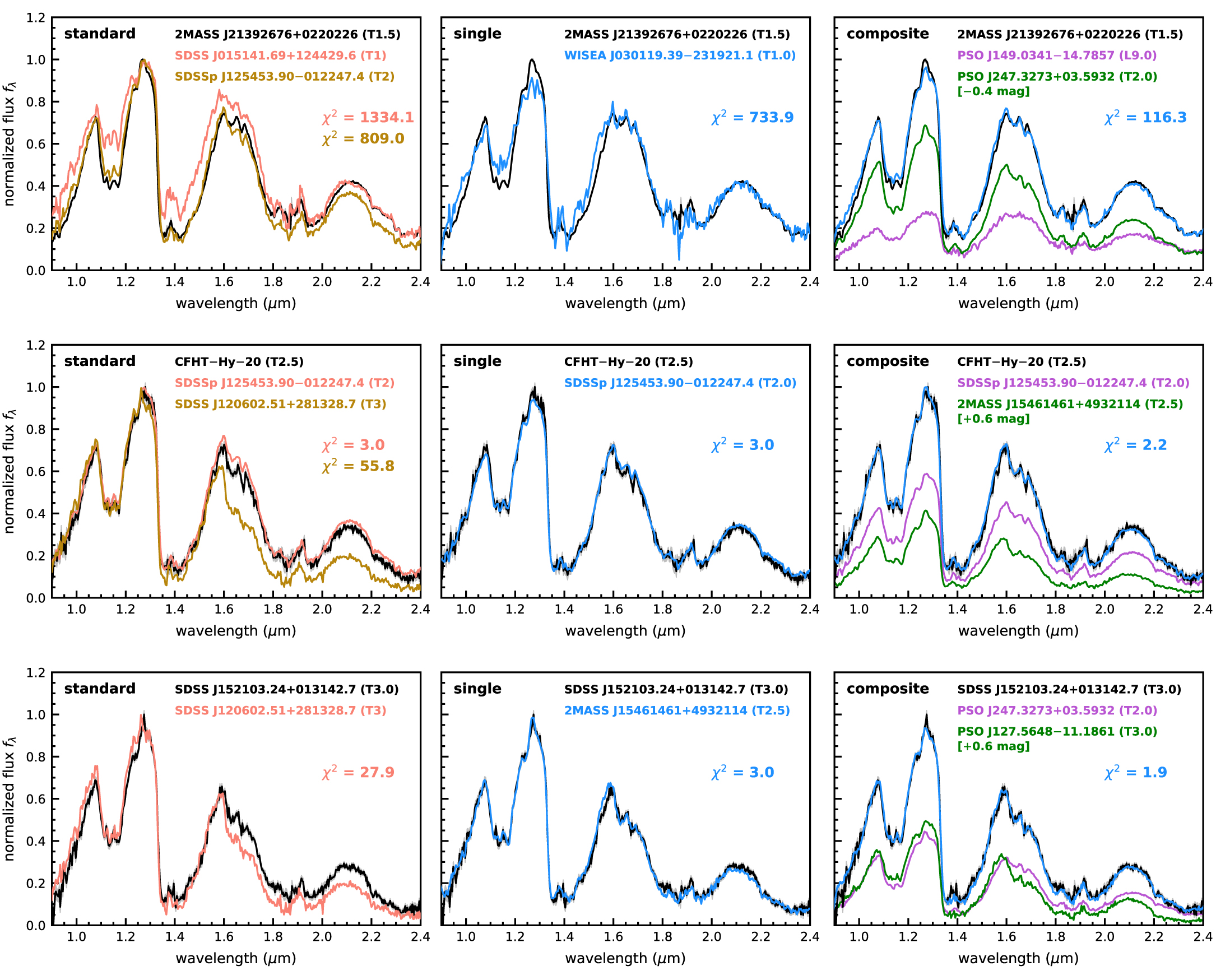
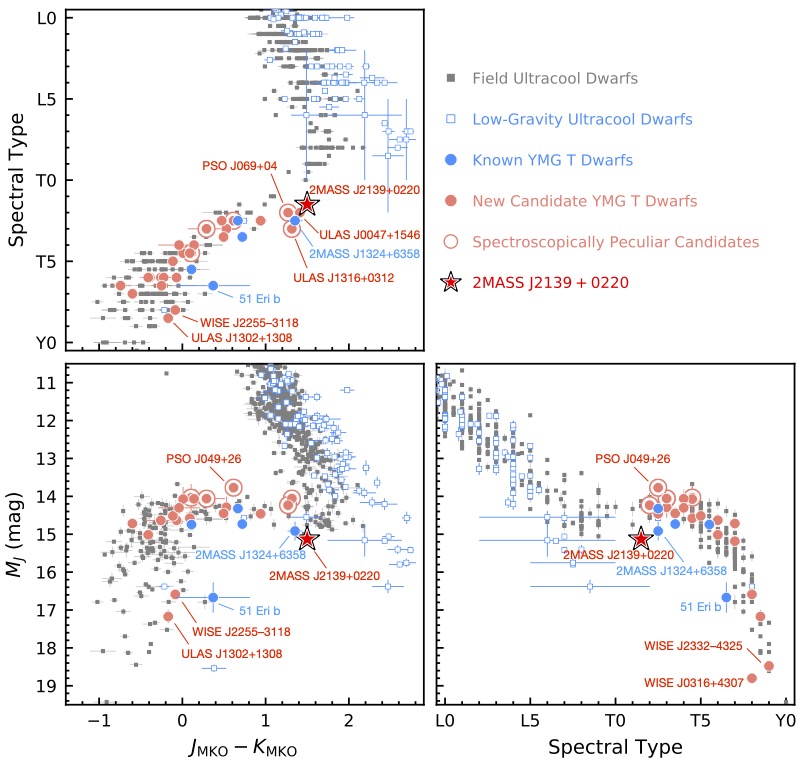
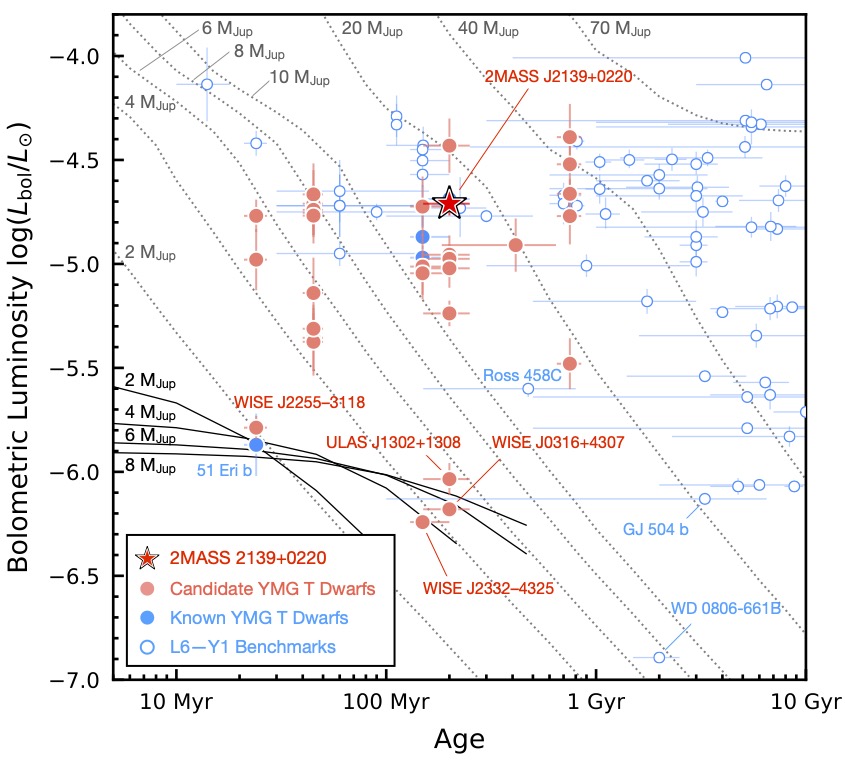
The Pan-STARRS1 Proper-motion Survey for Young Brown Dwarfs in Nearby Star-forming Regions.
The Pan-STARRS1 Proper-motion Survey for Young Brown Dwarfs in Nearby Star-forming Regions is a program that uses Pan-STARRS1 photometry and astrometry to search for young free-floating planets and brown dwarfs in several nearby star-forming regions, such as Taurus, Upper Scorpius, and rho Ophiuchus.
- Paper I: New Young Free-Floating Planets in Taurus & A Reddening-free Spectral Typing Method (Zhang et al. 2018, ApJ, 911, 7)
The Pan-STARRS1 Proper-motion Survey for Young Brown Dwarfs in Nearby Star- forming Regions. I. Taurus Discoveries and a Reddening-free Classification Method for Ultracool Dwarfs
Abstract
We are conducting a proper-motion survey for young brown dwarfs in the Taurus-Auriga molecular cloud based on the Pan-STARRS1 3π Survey. Our search uses multi-band photometry and astrometry to select candidates, and is wider (370 deg2) and deeper (down to ≈3 MJup) than previous searches. We present here our search methods and spectroscopic follow-up of our high-priority candidates. Since extinction complicates spectral classification, we have developed a new approach using low-resolution (R ≈ 100) near-infrared spectra to quantify reddening-free spectral types, extinctions, and gravity classifications for mid-M to late-L ultracool dwarfs (~ 100–3 MJup in Taurus). We have discovered 25 low-gravity (VL-G) and the first 11 intermediate-gravity (INT-G) substellar (M6–L1) members of Taurus, constituting the largest single increase of Taurus brown dwarfs to date. We have also discovered 1 new Pleiades member and 13 new members of the Perseus OB2 association, including a candidate very wide separation (58 kau) binary. We homogeneously reclassify the spectral types and extinctions of all previously known Taurus brown dwarfs. Altogether our discoveries have thus far increased the substellar census in Taurus by ≈40% and added three more L-type members (~ 5–10MJup). Most notably, our discoveries reveal an older (>10Myr) low-mass population in Taurus, in accord with recent studies of the higher-mass stellar members. The mass function appears to differ between the younger and older Taurus populations, possibly due to incompleteness of the older stellar members or different star formation processes.




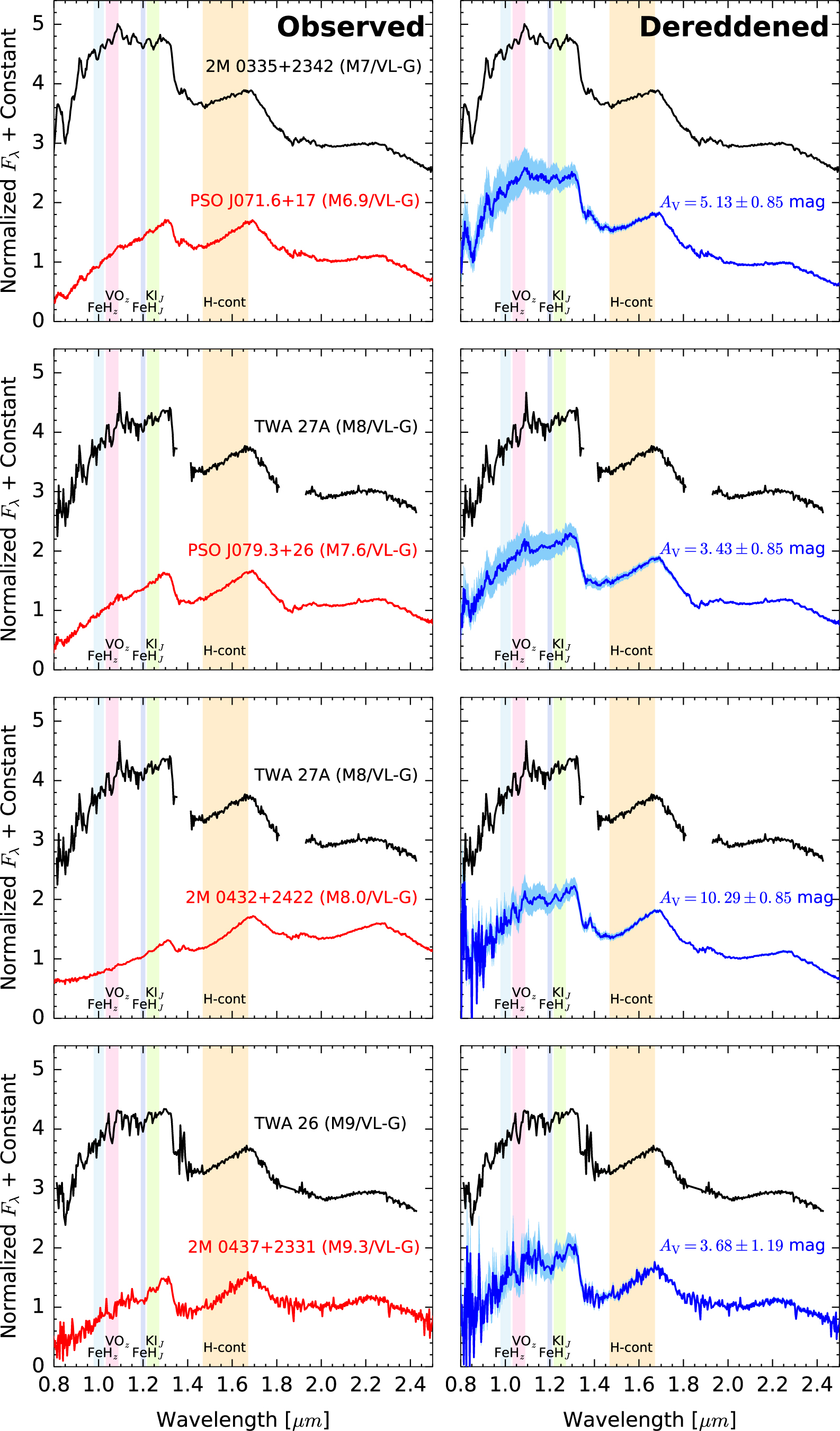

- The updated architecture of the Kepler-444 Planetary System (Zhang et al. 2023a, ApJ, 165, 73)
The McDonald Accelerating Stars Survey: Architecture of the Ancient Five-planet Host System Kepler-444
Abstract
We present the latest and most precise characterization of the architecture for the ancient (≈11 Gyr) Kepler-444 system, which is composed of a K0 primary star (Kepler-444 A) hosting five transiting planets and a tight M-type spectroscopic binary (Kepler-444 BC) with an A–BC projected separation of 66 au. We have measured the system’s relative astrometry using the adaptive optics imaging from Keck/NIRC2 and Kepler-444 A’s radial velocities from the Hobby-Eberly Telescope and reanalyzed relative radial velocities between BC and A from Keck/HIRES. We also include the Hipparcos-Gaia astrometric acceleration and all published astrometry and radial velocities in an updated orbit analysis of BC’s barycenter. These data greatly extend the time baseline of the monitoring and lead to significant updates to BC’s barycentric orbit compared to previous work, including a larger semimajor axis (a = 52.2 +3.3/-2.7 au), a smaller eccentricity (e = 0.55 ± 0.05), and a more precise inclination (i = 85.4 +0.3/-0.4). We have also derived the first dynamical masses of B and C components. Our results suggest that Kepler-444 A’s protoplanetary disk was likely truncated by BC to a radius of ≈8 au, which resolves the previously noticed tension between Kepler-444 A’s disk mass and planet masses. Kepler-444 BC’s barycentric orbit is likely aligned with those of A’s five planets, which might be primordial or a consequence of dynamical evolution. The Kepler-444 system demonstrates that compact multiplanet systems residing in hierarchical stellar triples can form at early epochs of the universe and survive their secular evolution throughout cosmic time.
